Orthodox Church in America Diocese of New York & New Jersey Fall / Winter 2023
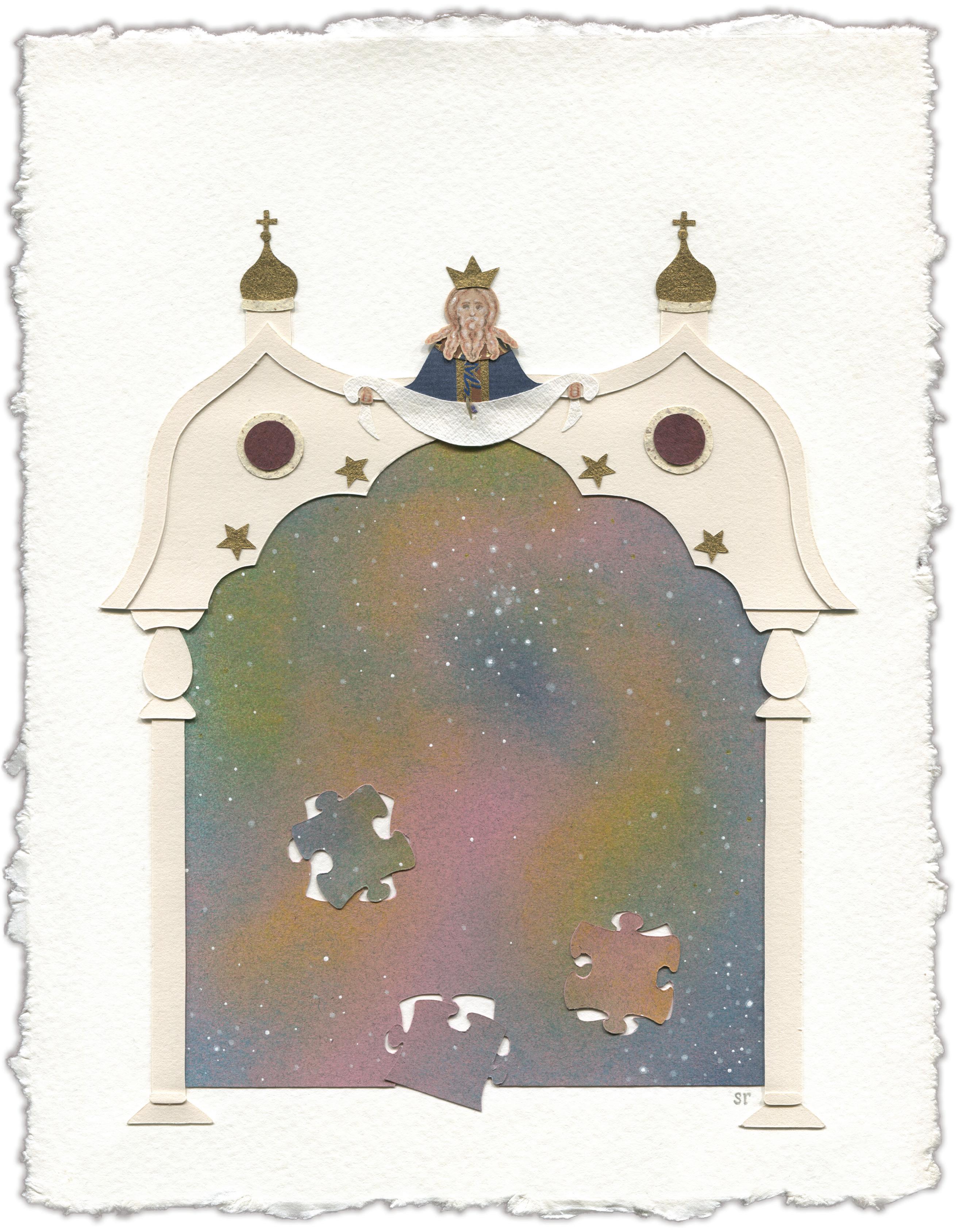
Harmony Discord
Published with the blessing of His Eminence, The Most Reverend Michael, Archbishop of New York and the Diocese of New York & New Jersey
Editor-in-Chief
Presbyter Matthew Brown
Acting Editor-in-Chief
Nick Tabor
Assistant Editor
Amelia Antzoulatos
Assistant Editor
Samira Kawash
Copy Editor
Deacon David Maliniak
Art Direction & Design
Sophie Ries
Publication Office
33 Hewitt Avenue, Bronxville, NY 10708
Website www.jacobsmag.org
For digital subscriptions and to connect with us on social media, please visit our website.

Fall/Winter 2023: "Harmony and Discord"
Jacob's Well
Opportunities
Want to be a part of Jacob's Well? We are looking for experienced individuals to fill the following positions: Printing Manager and Director of Digital Publications. We are also always looking for writers and artists who want to contribute their work. If you are interested and possess the necessary skills, or if you would like more details about sponsoring an issue, contact us at priestmatthewbrown@gmail.com.

Materials published in Jacob's Well are solicited from its readers voluntarily, without remuneration or royalty payment. The publishers and the staff of Jacob's Well assume no responsibility for the content of articles submitted on this basis.
Material herein may be reprinted with acknowledgement.
Send comments, corrections, or suggestions for potential articles to priestmatthewbrown@gmail.com.
Front Cover
Harmony and Discord (2023)
Sophie Ries
Frontispiece
Attersee (1900)
Gustav Klimt

Back Cover
Plaque with Christ Blessing (ca. 1190–1200)
French, copper and enamel
Letter from the Editor by Nick
Tabor
Life in the Time of COVID by Archpriest
Eric Tosi
Making Faith Come Alive by Kristina
Baktis
Three Days in the Adirondacks
Interview with Presbyter Martin Kraus
Letter From the Catskills by Beatrice Olderog
A Unity of Vision by Doyin
Teriba
In Praise of Dissonance by Benedict
 and Talia Sheehan
and Talia Sheehan
War as a Challenge for the Christian Vision by Sergei Chapnin and Presbyter Matthew
Religio as a Universal Human Quality by Jesse
Hake
Achieving Harmony Through Conflict by John
Livick-Moses
Christianity's Asian Future by David
Armstrong
Brown
Contents Daily Bread 40 44 48 52 55 56 57 58 | Family Life | Family Fissures by Amelia Antzoulatos | Theology & Culture | The Two Alexanders in My Life by Archpriest Michael Meerson | Church History | A Measure of Kinship by Presbyter Mikel Hill | Spirituality | Praying for Parking by Samira Kawash | Poetry | Coracle by Scott Cairns Sudden Storms by Sherry Shenoda Watermelon Seeds by Sherry Shenoda | Youth Pages | 2023 Diocesan Graduates Diocesan Life
6 10 12 15 16
4
Feature Essays 18 22 26 32 36
Letter
Editor
by NICK TABOR
The scriptures and our liturgical prayers are forever extolling the importance of unity and harmony. “For the union of all, let us pray to the Lord,” we hear in every litany. The Psalmist writes of “how good and pleasant it is when brothers dwell in unity,” and St. Paul urged the church in Rome to “live in harmony with one another.” Likewise, the Proverbs describe “a man who sows discord among brothers” as one of the seven things the Lord considers an “abomination.”
And yet, we all know from experience that conflict is a routine, not to say elemental, part of church life. Even in the best of circumstances, our fellow parishioners’ personalities sometimes grate on us. Parish councils inevitably clash over building projects and other questions of money. And if we’ve been around long enough, we’ve seen priests and bishops get caught up in scandals: perhaps embezzling funds, carrying on extramarital affairs, or even committing abuse or helping to cover it up.

Moreover, in this moment, it’s safe to say that we’re not living in the best of circumstances. The Orthodox world, both in the U.S. and worldwide, seems more divided than it’s been at any other time in recent history. In many American parishes, the COVID pandemic created massive new rifts within congregations, as we disagreed about which safety precautions were appropriate—from suspending services to mandating face masks. Though we’ve all gone back to church now, more or less, and discarded our N95s, those clashes haven’t necessarily been forgotten. No doubt many parishioners think about one another differently now than they did in 2019.
More important, Russia's invasion of Ukraine has been disastrous for ecclesial relations, as Patriarch Kirill and other leaders of the Russian Orthodox Church have rallied in support of Vladimir Putin’s administration. Setting geopolitical questions aside,
it’s been heartbreaking to see images of churches like the Transfiguration Cathedral in Odessa largely in ruins—to say nothing of the tens of thousands of people who have been killed and the millions more who have been driven from their homes. More than a few Orthodox voices have likened the invasion to the sin of Cain. Hundreds of priests in Ukraine, and laypeople around the world, have called for Kirill’s ouster.
In moments like these, our prayers for the “union of all” can sound like nothing more than wishful thinking. We find ourselves confronting an impossible gap between the lofty rhetoric of our church texts and our lived experiences. We’re forced to reflect on what the calling to harmony demands of us in a world of such discord.
To begin with, the analogy to music is helpful here. Musical harmony is a kind of unity that depends on differentiation. It’s a moment of togetherness and individuality at the same time, where the voices neither merge nor clash. Applying this to the church, we might say that disagreements are part of a harmonious community life—they’re not antithetical to it.
In their essay in this issue, “In Praise of Dissonance,” the church musicians Benedict and Talia Sheehan go a step farther, arguing that even too much harmony can be destructive. “In any given piece of music, it is the interplay between consonance and dissonance, the dance between tension and resolution, that creates movement and gives music its sense of direction and meaning,” they write. Extending this to a social context, they argue that when there’s “too much similarity of perspective,” a community can “spiral out of control.”
This interplay is something we especially strive for in the Orthodox tradition. We have less centralized authority than the Roman Catholic Church but a far greater sense of unity than Protestants do. And we celebrate distinct ethnic cultures as an integral part of our spiritual lives, but we try—at least in our better moments—to do this without losing sight of the universal elements of our faith, the ones that transcend ethnicity.
It’s a difficult balance to strike. Some of us tend to oversimplify the Orthodox tradition, to imagine that it’s monophonic. But it has spanned
jacob's well 4
FROM
THE
many cultures over a period of 2,000 years, and it has seldom convened its leaders to issue definitive theological decrees. The bounds of what has been accepted as Orthodox over the centuries—in theology, liturgical practices, and other areas—are broader than we might imagine.
But of course, there are limits. There’s a reason we recite the Nicene Creed at every Divine Liturgy: It’s an expression of our core beliefs as a group, of the teachings that bind us together.
However, even in cases where one party is definitively in the wrong, the conflicts we experience often resolve into a greater harmony. In centuries past, the Church’s very dogma, including its core teachings on the nature of Christ and the process of salvation, were only arrived at after many rounds of intense, often bitter conflicts. The catalyst for each of the Ecumenical Councils—at least according to conventional wisdom—was that false doctrines were circulating, forcing Church leaders to clarify the official teachings.
Of course, only so much depends on us as individuals. What are we to do in the face of catastrophic conflicts like the one centering on Ukraine, where our prayers and personal humility can’t produce accord among our hierarchs—let alone cause the violence to cease?
Sergei Chapnin and Fr. Matthew Brown reflect on this question in another essay in these pages, “War As a Challenge for the Christian Vision.” In the case of the Ukraine war, they argue, almost any hardline position would be misguided. The just-war theory that originated with St. Augustine has no place in Orthodox tradition; “at best, war can be the least bad option in a fallen world.” At the same time, in their view, to suggest that God has condemned all violence would also be a departure from the mainstream of Orthodox teaching. Absolutist ethics like pacifism “overlook the personal dimensions of moral choices,” they argue, “and ignore the moral burdens placed upon each of us to discern what is good in each situation.”
Nevertheless, we wouldn’t want to suggest that all conflicts are beneficial. Within our parishes—and within our families, and among our friends—they can also be destructive and tragic. Generally, our spiritual tradition urges us to look inward, to consider how we might personally be at fault before we level criticisms at others. And when we find ourselves at odds with the people around us, we shouldn’t only ask whether we’re in the right; we should also ask whether the fight is worthy. St. Paul’s words to his disciple Timothy come to mind: “Have nothing to do with stupid, senseless controversies; you know that they breed quarrels.” He goes on to say that a Christian must be “kindly to everyone.”
In his essay for this issue, John Livick-Moses, a licensed clinical social worker, explains that when his patients are having troubles with their partners or family members, they often have better results when they set aside the instinct to criticize, or to defend themselves, and instead approach the other person with genuine curiosity. “I’ve seen many cases where someone’s true motives or concerns are hidden behind other issues in the midst of conflict,” Livick-Moses writes. “By asking questions and maintaining empathetic curiosity, we may realize that a more profound pain is present.”
More broadly, in the face of conflicts beyond our control, prayer is the most fundamental and obvious response—but it’s not enough. “Christians should think creatively about how they might help,” they write, citing the work of Dr. Paul Gavrilyuk and his team at Rebuild Ukraine, who deliver aid to suffering Ukrainians, as one possible model in the present conflict.
Finally, a little historical perspective might help. It can be easy to lapse into sentimentalism about Christian history, to imagine that our forebears worked out their differences more amicably. But since the days of the Church as chronicled in the Book of the Acts of the Apostles, bitter infighting has been as much a staple of ecclesial life as prayer and forgiveness. If we remember that the Body of Christ has survived worst scandals in the past, it might help us stave off despair about the present and future.
5 jacob's well
NICK TABOR is a freelance journalist and the Acting Editor-in-Chief of Jacob's Well. His first book, Africatown: America's Last Slave Ship and the Community It Created is forthcoming from St. Martin's Press. He is a parishioner at the Cathedral of the Holy Virgin Protection in Manhattan.
Life in theTime of COVID
HOW A CHALLENGE BECAME AN OPPORTUNITY
hen COVID hit, I don’t think anyone foresaw the effect it would have on us as individuals and as parish communities. It is certainly easy to look back now and judge whether we did things correctly, but the reality was that we had to live in the moment. As the new rector at St. Gregory the Theologian, I had to think very clearly and consider carefully how to proceed because it would determine not only how we survived this period, but also how to emerge with an intact parish. This dilemma likely impacted every parish as they faced this unique situation.
At the outset, I established two guiding principles for our path forward and discussed them with the parish and the parish council. First, we would not divide the parish over COVID. There were people on both sides of the issue and their positions covered just about every facet of it (as was also reflective of society as a whole). In whatever position you took, one could be categorized as uncaring or an extremist. This needle had to be threaded very carefully lest it explode in the parish community. Second, and in my mind, more importantly, we would
maintain a semblance of church life in the face of lockdowns and restrictions. You could only do so much, yet somehow you had to keep the church together and move forward. There was no “magic” or simple solution. But I knew we had to do something—anything—and I explained to the parish that we were not to see this as anything but an opportunity. This was our evangelistic moment, and it did, in fact, move us in unexpected ways.
My years of studying, implementing, and teaching evangelism suddenly came to the forefront because the circumstances invoked the same guiding principles seen in evangelism— keeping the church together and functioning as a church. I have always gone back to the church Fathers when confronted with a question, and over the years I have relied especially on St. Innocent’s “Instruction to Missionaries,” in which one can find a plethora of practical and eminently applicable principles.1 One of his principles is that “Methods of instruction may vary according to the state of mind, age, and faculties of him who is to be instructed…to these facts should be adapted the method and
1 For a .pdf, see St. Innocent of Alaska: Instructions to a Missionary (catacomb.xyz)

jacob's well 6
order of instruction in the saving truths.” In other words, know your people and what they can handle and teach and lead them accordingly. It is from this perspective that we stepped up to face the opportunity.
Hewing to the guiding principles I’d established—remaining united as a parish and maintaining some form of church life—seemed to call for the use of technology. Fr. Alexander Schmemann had written in a 1966 essay entitled The Task of Orthodoxy Theology in America Today, “Everywhere, and not only in the West, (Orthodoxy) is challenged by a secularistic,
“Orthodoxy 101.” We did what we could in whatever way we could. As for our parishioners, we maintained our sense of community by calling each other frequently and speaking over Zoom. Other parishes were doing the same, so our approach was not unique, but we invested time and effort into this. We were even able to travel as a parish (via Zoom) to Alaska and other places of note in the Orthodox Church. We tried to keep it interesting but, more importantly, relevant and infused with the Church, and this made the difference. We were able to hold the church substantially together and keep the church services as alive as possible.
Meanwhile, outside of our community, many people were experiencing an acute spiritual hunger. No doubt many of them had felt it before the pandemic started, but it seems it was intensified by the isolation that the lockdowns brought on. These seekers wanted a foundational spiritual life—a deeper relationship with God and with a community. Often, they turned to the only venue that was available in those months: social media. As we all know, the internet can be a dangerous place, especially for spiritual
technological, and spiritually antagonistic culture which virtually swallows its younger generation.”2 Yet, St. Nikolai Velimirovich wrote, “Technology is deaf, mute, and unanswering. It is completely dependent on ethics, as ethics on faith.”3 Although both can be true at the same time, how we used technology would be the critical and deciding factor. Was it going to keep us together and move us forward or divide us and destroy our community?
We decided to use technology to live-stream the services on various platforms, even when celebrated only by me and a chanter. I also started a live-streamed instruction series entitled
2 Protopresbyter Alexander Schmemann: The Task of Orthodox Theology in America Today
3 Ethics and Technology (orthodoxinfo.com)
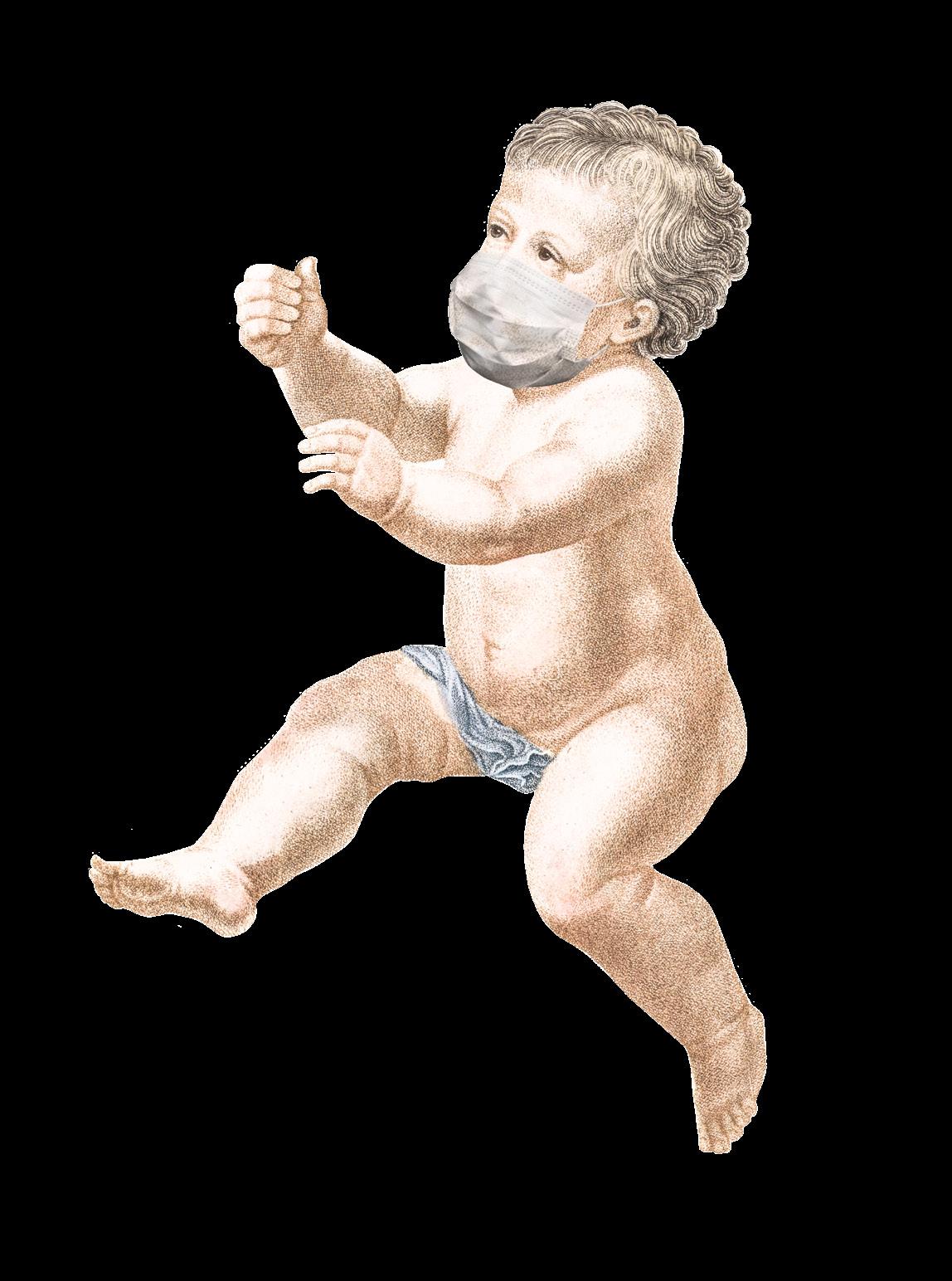
7 jacob's well
"There was no “magic” or simple solution. But I knew we had to do something—anything—and I explained to the parish that we were not to see this as anything but an opportunity."
seekers, but it can also be a hub for meaningful connections. It was on the internet that the path of St. Gregory’s coincided with the path of these spiritual seekers. They managed to find us.

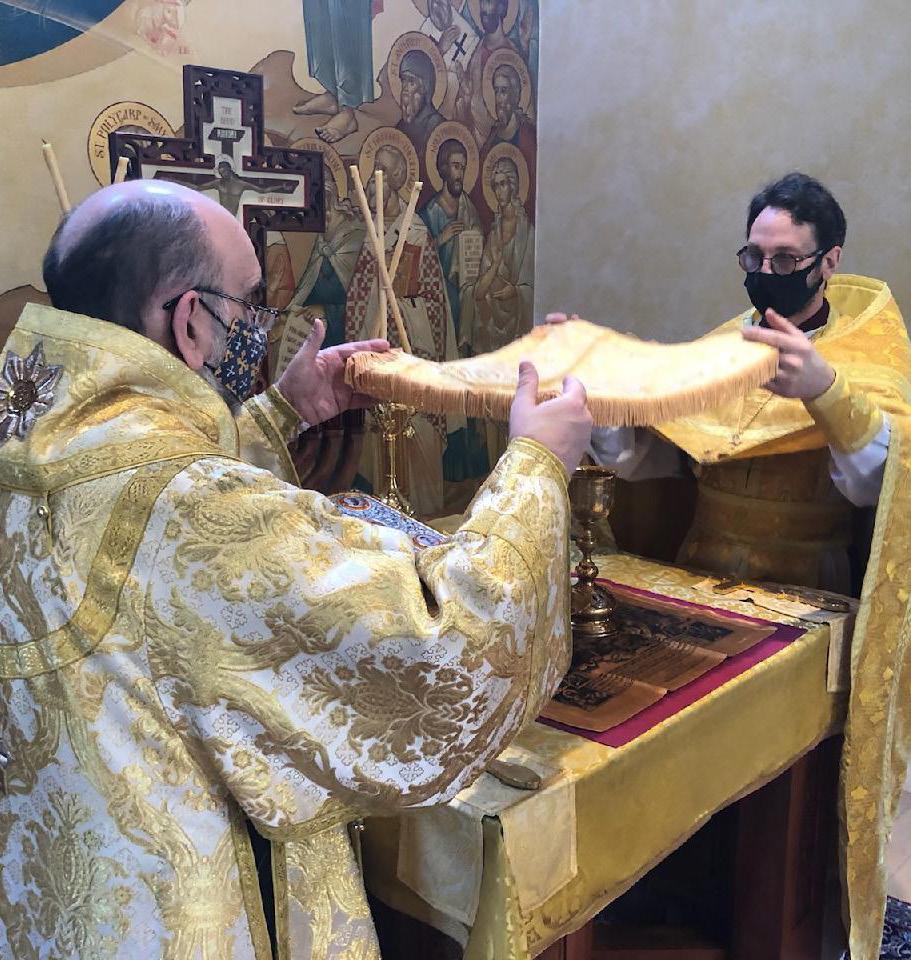
We have heard and read much about the new generation of “nones;” that is, people who profess no religious faith of any kind. Many books and articles have been written about them. Some of us have certainly encountered them in our own parish lives. But COVID seemed to allow these “nones” to examine their lives anew and rethink questions of faith. This was a gift to the Church because we had answers to many of their questions.
Meanwhile, perhaps in contradiction to the above statement, there was another phenomenon among a group of seekers which I had seen but not to the level that I have now experienced. Many of these “nones,” as they read extensively about the Orthodox faith, had very little, if any, Christian foundations from which to interpret Orthodoxy. They simply were not raised in, nor had they practiced, any semblance of Christian faith and so when they discovered Orthodoxy, they had many questions as to exactly what the Christian faith is. They were a tabula rasa or “clean slate” on Christianity. This presented a great opportunity because I did not have to undo any presumptions, but rather was able to build up their understanding of God from the very basic foundations. Better to do than undo.
However, these “nones” also were very alert. What they saw had to match what they had read or seen on the internet. They could spot hypocrisy quicker than anything else. What we did as a church community, whether in liturgics, teachings, social outreach, fellowship, whatever, had to match what we preached and taught. Otherwise, they would simply turn right around and leave…and perhaps rightly so. If we claimed to be Christians, then we had to act and believe as Christians.
This meant I had to start by explaining the Trinity, Who and what Jesus Christ is, and why He became incarnate, was crucified, and arose from the dead. Incidentally, this is just what St. Innocent encouraged in his “Instructions:” to start catechesis with Creation, the Fall, and humanity’s need for Christ. He counseled that everything else will follow from that. I spend much time with seekers on these topics before we discuss the Orthodox Church. If we do not know Christ, we cannot know His Church. I’ve found that the new seekers are looking for a Christ who is one of the Holy Trinity—not a good buddy, nor a magician who can make all their problems disappear. This inevitably leads to a deeper understanding of worship and why we Orthodox worship as we do. Finally, it helps them grasp another critical point: that no one can be a Christian alone.
jacob's well 8
As we have noted, the internet gives rise to its own communities. These are fascinating, because they can cover just about any shared interest you can think of (and many you could never have imagined). But in many ways, these communities are ethereal—even though they may feel real. Even when they comprise groups of Orthodox Christians, they can be sources of connection and encouragement, but they don’t form bodies of collective worship. As Metropolitan Kallistos Ware wrote, “As Christians we are here to affirm the supreme value of direct sharing, of immediate encounter—not machine to machine, but person to person, face to face.”
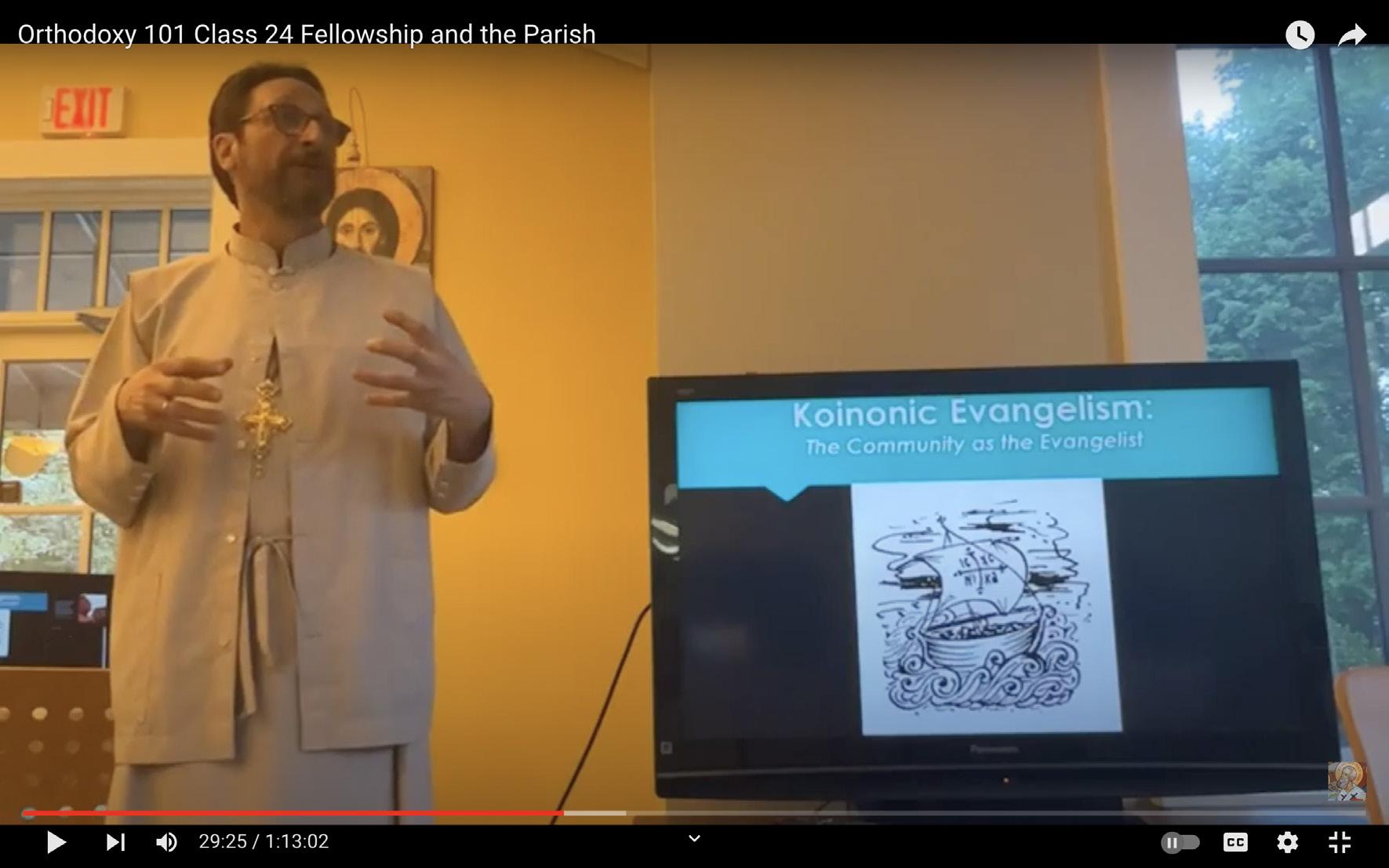
This was the challenge—particularly during COVID, when even our regular parish community could not meet in person. I ended up catechizing one family via Zoom and then chrismating them after the parish reopened. But that certainly was not ideal. Once the seekers were able to come into the church, participate in the worship, and integrate into the community, all the pieces of their informal and formal education came together.
But the critical decision we made early on, to make sure we kept together as a community, even remotely, was the key factor that led to these newcomers joining us. If they had seen infighting and division, it’s unlikely they would have stayed. But instead, as they came to the services, met one
another, and became a part of the community, this led them to desire a deeper relationship with Christ and the Church. They had to be part of the “face-to-face” encounter.
St. Nikolai of Zica, when advocating for the use of English in American Orthodox parishes, once wrote, “We must be super-conservative in preserving the Orthodox faith, and supermodern in propagating it.” I believe we did just that. However, I also try to keep in mind a passage from the Apostle’s first letter to the Corinthians: “I planted, Apollos watered, but God gave the growth” (1 Corinthians 3:6). It was not me alone, or the community alone, or even our efforts combined only with those of the seekers, who found the right place at the right time. Rather, it was God who brought them to a place that was ready to receive them, nurture them, and ultimately bring them into the Church.
9 jacob's well
V. REV. ERIC TOSI is assistant professor of pastoral theology at St. Vladimir’s Seminary, the chairman of the Commission on Missions and Evangelism for the Diocese of New York and New Jersey (OCA), and the former secretary of the OCA. He is the rector of St. Gregory the Theologian Church in Wappingers Falls, New York.
Still from an "Orthodoxy 101" video on the parish YouTube channel.
by KRISTINA BAKTIS
Ihave the privilege of leading the Children’s Ministry at Mother of God Orthodox Church in Princeton, NJ. My faith grew out of my participation in the services as a child. In turn, I want to provide the children of our parish with opportunities for their own faith to flourish.
Orthodox Christian worship is experiential in nature, accomplished through participation in the Divine Liturgy. Because the Orthodox Church affirms that a baptized person, even an infant, is a full member of the Body of Christ, children’s participation is essential to the formation of their faith. As Fr. Alexander Schmemann reminds us:

“Only when a particular teaching of the Church—or as we say, a dogma, an affirmation of some particular truth—becomes my faith and my experience, and therefore the main content of my life, does this faith come alive. If one reflects on faith and thinks about how it passes from one person to another, it becomes obvious that what really convinces, inspires and converts is personal experience. This is especially important in Christianity, because, in its essence, Christian faith is a personal encounter with Christ…”1
At Mother of God, we are creating opportunities to make “faith come alive” for the children of our parish. The children hold candles during the Little Entrance and Gospel reading, carry icons and candles during the Great Entrance, take the collection, and distribute antidoron. Having these “jobs” makes church meaningful while educating them about their faith. During a Divine Liturgy last year, I recall how a boy waiting for the Great Entrance examined the icon of Christ crucified that he was holding and asked me, “Why did they use nails? That would hurt. They could have used super glue.” This observation opened a discussion about Holy Friday and why anyone would want to hurt Jesus. We also discussed that
because Jesus knows how it feels to be physically and emotionally hurt, He understands our pain and wants to help us.
Throughout the year we combine participation with explanation to orient children and adults to the liturgical cycle of the Church.
On Palm Sunday we connected the hymnology of the church with experience. Before the feast, the children had a lesson to discuss the feast day, the icon, and the troparia. We focused on the role that children played in Christ’s entrance into Jerusalem. Then they made banners that read, “Hosanna in the Highest!” The children took pride in their banners and their role in the service, occasionally waving to their parents and grandparents. The congregation experienced the hymn come alive as children with their banners and “palms of victory” led the way in the festive procession.
For Pascha, the children made banners that read, “Christ is Risen!” They also learned that sometimes it’s ok to be loud in church if you’re shouting “Christ is Risen! Indeed He is Risen!”
During Advent, children learned about the different themes of the fast and preparation for the Nativity. Every week the children would write their own prayer inspired by the weekly theme. Fr. Peter would read their prayers to the congregation while a child lit the candle on the Advent wreath. Their prayers were like petitions recited during the litanies. They included prayers for loved ones, plants, animals, and the planet, and to protect people from the dementors (the creatures in the Harry Potter series that drain humans of their hope and joy). The parish learned the themes of Advent and deepened their own faith and understanding.
In November we connected Thanksgiving to the life of the Church in a lesson called “Eucharist means Thanksgiving.” The children (and parents) learned how to make prosphora. The children discussed what they were thankful for. They wrote down the names of loved ones to pray for, living
jacob's well 10
1 The Celebration of Faith, vol. I: I Believe… Sermons, Volume I. Alexander Schmemann. Translated from the Russian by John A. Jillions. St. Vladimir’s Seminary Press, 1991.
and departed, and put them with their prosphora. On Sunday, the entire parish witnessed the vesting of the priest and deacon and the service of Proskomide. Many adults in our parish had never seen this service. The entire congregation was edified because we involved the children in worship.

Participation in the divine services allows us to become a witness to Christ in the world. Fellowship after the service also has a central role at Mother of God, and we have many ways to include children in our vibrant parish life. Our Matronal feast day is celebrated with a fall picnic and decorating pumpkins. In December, St. Nicholas fills the children’s shoes with treats, and they decorate the church's Christmas tree. At our Pascha BBQ, children participate in Easter egg hunts and games. Due in large measure to our active Children’s Ministry, parishioners feel comfortable inviting non-Orthodox friends and family to attend our services and participate in fellowship. Many families hold birthday parties and baby showers at the church, creating a feeling of continuity and wholeness between the spaces of family and faith. These events build community within our parish and witness of our faith to the larger community.
I return to Fr. Alexander’s words: “Only when a particular teaching of the Church—or as we say, a dogma, an affirmation of some particular truth— becomes my faith and my experience, and therefore the main content of my life, does this faith come alive.” After making prosphora, a girl declared, “When I grow up, I’m going to have all the church school kids over to my house and teach them how to make bread.” Making prosphora became her experience and her faith came alive. A living faith that she wants to share with others. May you be inspired to find ways to make “faith come alive” in your community.
11 jacob's well
Group in a Romanian Procession (1909)
Marianne Stokes
KRISTINA BAKTIS is a licensed art therapist. She is a member of OCAMPR and a board member of the St. Phoebe Center for the Deaconess. She is a parishioner at Mother of God Joy of All Who Sorrow in Princeton, New Jersey.
Three Days in the Adirondacks

REV. MARTIN KRAUS ON A DIOCESAN CAMPING TRIP
Last fall, men from three parishes in our diocese took a camping trip in the Adirondacks, led by Fr. Martin Kraus. They hiked, made campfires, and conducted Divine Liturgy in the wilderness. It was the first instance of an event Fr. Martin hopes will become a yearly tradition. Fr. Martin joined us to describe the experience and to talk about his love for the outdoors.
To begin with, could you tell us a little about yourself and your parish?
Yeah. I graduated from St. Vladimir's Seminary in 2002. I was the priest at St. Vladimir Church, in Trenton, New Jersey, for five years, and then I came here to Holy Trinity, in East Meadow, in July of 2007. My wife's name is Dennise. We met in college at Drexel University, and we got married in ‘93. We have five children.
As for Holy Trinity, it’s the first Orthodox parish here on Long Island—it was established back in 1924. It's a beautiful community. We have a beautiful property where we hold a festival and other functions for the church.
jacob's well 12
We’re here to talk about the annual camping trip—or retreat?—that you launched last year. How did that come about?
I'm the youth chaplain for the diocese, so I’ve been involved with all the youth events and retreats, and with our summer camp, for about four years now. My wife and I started by helping with a horticulture week the first year. The next year, we were asked if we would be interested in coming for teen week. This year they added a second teen week—so it’s growing.
Last summer, at the end of teen week, Greg Fedorchak and his wife were there helping. Also, there was one of the counselors, Delbert Clement. They were just chatting at the end. We were just finishing up and getting ready to go, and said, ‘Hey, we would love for us guys to be able to do more together.’ They were joking with me, and they said, ‘Do you know a priest who likes to camp, or who might be able to run something like that?’ I said, ‘I think I might know somebody.’ We started talking about it more seriously. Dell was key to the trip, because when he was growing up, he had camped at this Cedar Lakes campsite in the Adirondacks.
Then we were in a mad rush to get ready because it was July when we talked about it, and we actually did the trip in late October. It took a lot of preparation. I was a little concerned about it being too big the first time around. And for first-time campers, I knew it was going to be cold—there would be freezing temperatures at night. We also wanted to make sure we would be able to have Divine Liturgy out there.
Interesting—we’ll come back to that later. But how many people came out for it?
We had 10 guys, between the ages of 16 and 69, I believe it was.
And what did the weekend consist of?
then we did a compline service. Then we had this very interesting experience. We were just hanging around the fire, eating dinner, and this huge, menacing dog showed up. It was sniffing us. Next a bunch of hunters came over. They were camping next to us, drinking beer. They started joking with us, and we got to know each other. We told them we were going to be hiking the next day, and we asked if they knew where to find good firewood. They said, ‘Don't worry about it, we'll take care of it for you.’
The next morning, when we woke up, it was beautiful. The sun was rising over the mountain—I think it was Wakely Mountain. All the grass was white and frosty from the dew and the fresh, cold air.
Later we went hiking up this trail. It was about a five-mile roundtrip. When we came back, we were coming around the trail, and we noticed all the guys over by our campsite. We were thinking, What are they doing? They were chopping wood for us. We didn’t even know these people! It was really special. One of the hunters and I talked for a while about our sons. It was nice to meet strangers and talk about life in general, and family, and just be friendly to each other. That's the camping experience I've always had, and it was nice to have that again, in the Adirondacks.
What was the hiking like?
Well, the first part was marshy and wet. After about two miles, you have some makeshift bridges you’ve got to cross to get over those streams. That last mile up was something else. For the most part, we had no signal at all for our phones—so we didn’t have internet out there, which was another blessing of the trip. But I was a little concerned, because Archbishop Michael wanted to get a message to everybody on the trip. I was thinking, I don't know how I'm going to get this message from him.
We got there on a Friday evening. The most important thing is getting food in you when everybody gets there. I cooked a big pot of vegetable soup for everybody that evening, and
When we were heading up this mountain, the last mile was like going up a staircase. I think it was 1,500 feet up. There were a couple of clearings where we were able to look out and see the view, which is spectacular. I think the elevation there is about 3,700 feet. As you get up to the pinnacle,
13 jacob's well
there’s a 70-foot fire tower, which is one of the highest points in the area. We started getting a phone signal. As we were reaching the peak, a voice message came in from Archbishop Michael.
Wow, perfect timing.
But even more so, because one of the things he talked about was Elijah going to the top of the mountain to speak with God. It was in the small, still voice that he was able to speak to God. It was just a perfect parallel of Vladyka Michael blessing us on our trip. He didn’t know we were on our way to the top of the mountain right then, to see this amazing view.
What a serendipitous moment.
Yeah, it was really special. We spent a little bit of time up on the top, going up the tower. Once you get over the tree lines, you get a beautiful breeze coming over the top, and you have a 360-degree, panoramic view, with nothing but trees and lakes and mountains. No sign of civilization at all. It was just breathtaking.
That makes me want to get out into the woods.
Yeah, I just got back from camping with my own family in the Poconos. We love camping. I had always wanted to do a trip in my own parish, with some of the young men, to help them understand the importance of solitude and being in nature. It's like going back to our home, Adam and Eve in paradise. We can go out into the woods and get recharged and remember how important it is to take care of God's creation—to be stewards. It's something you must experience to really know.
Tell us more about conducting Divine Liturgy on Sunday.
I hauled out this altar table and oblation table and put together a makeshift altar sanctuary. We had the blessing of Vladyka Michael to do it. I got up at the crack of dawn, as the sun was rising. I dressed up the church with her adornments and put the gold covers. It was a very cold morning—it must have been in the thirties. I did the proskomedia as
other people were getting up. It was wonderful to all be together and go through this process of preparing to participate in the Divine Liturgy, as the sun was rising over the mountain peaks. We got a fire going. It was a nice way to finish up the weekend, for sure. After Divine Liturgy, we had our breakfast, and then we packed up and left.
But one of the first things I think of, when I think about camping trips, is the late-night fire, where there are maybe a few guys left, hanging by the fire, and just shooting the breeze. One night, I think
the youngest member and one of our older guys stayed up late. Those are the times when you really build your relationships with people. It creates that connection in a way nothing else really can.
Are you planning to do the trip again next year?
Yeah, in fact, word got out, and I know some people in upstate New York and other parishes, they want to be involved with it. We're hoping to do it in early or mid-September this year, so it won’t be as cold for some of the newcomers.
I think we'll probably have to limit attendance just to keep it controllable. We were hoping for about a dozen people the first time around, and this year we might expand it to 15 or 20.
—Interview by Nick Tabor
jacob's well 14
"We can go out into the woods and get recharged and remember how important it is to take care of God's creation—to be stewards. It's something you must experience to really know."
Letter from the Catskills
A TEEN PARISHIONER ON THE LENTEN RETREAT
by BEATRICE OLDEROG
ALenten retreat provides an opportunity for us to step away from our busy lives and focus on our spiritual growth. It allows us to disconnect from the distractions of daily life and engage in activities that foster a deeper connection with God.
I recently attended a Lenten retreat for teenagers that our diocese offers every year in the Catskills. The weather was much colder than we anticipated, and I didn’t bring enough warm clothes. But the snow-covered hills were so picturesque, it made up for the discomfort. In the end, the chilly temperatures and the heavy snow made the event even more memorable.
While many people may believe that spiritual growth must happen in some serious manner, I believe that fun experiences can also help us in our spiritual lives. This was made possible by this retreat. It consisted of morning and evening services, where we were able to listen to great sermons from a priest. During the day there were activities like candle making and team-building exercises, as well as time to simply relax and talk to others. One of the highlights was a presentation by Archbishop Michael, where he told us his life story and spoke about the history of our diocese. But aside from the formal program, I also enjoyed the chance to step outside my ordinary routine and spend some time in the wilderness. It gave me space for contemplation and personal reflection and helped me reconnect with God.
Besides teenagers from our diocese, there were also people there from Pennsylvania. There was a warm feeling among the whole group, and I
had several lively discussions with both counselors and campers about a variety of different topics. I had a very enjoyable conversation with a counselor about our experiences with different denominations. These discussions provided me with more spiritual insight and made the overall stay much more enjoyable.
In conclusion, I was able to make many connections which will hopefully last me a very long time. The time spent away from my phone provided me with ample room for contemplation. Most notably, I was able to simply spend time in nature while still having an opportunity to dedicate time to God. All in all, I would strongly advise anybody to take part in the retreat.
The Lenten Retreat for the current school year will be at Frost Valley YMCA Camp in Claryville, New York, between April 12 and 14, 2024. Middle School and High School students in grades 8-12 are encouraged to save the dates and attend. Registration will open in January. Announcements will be posted at www.nynjoca.org.
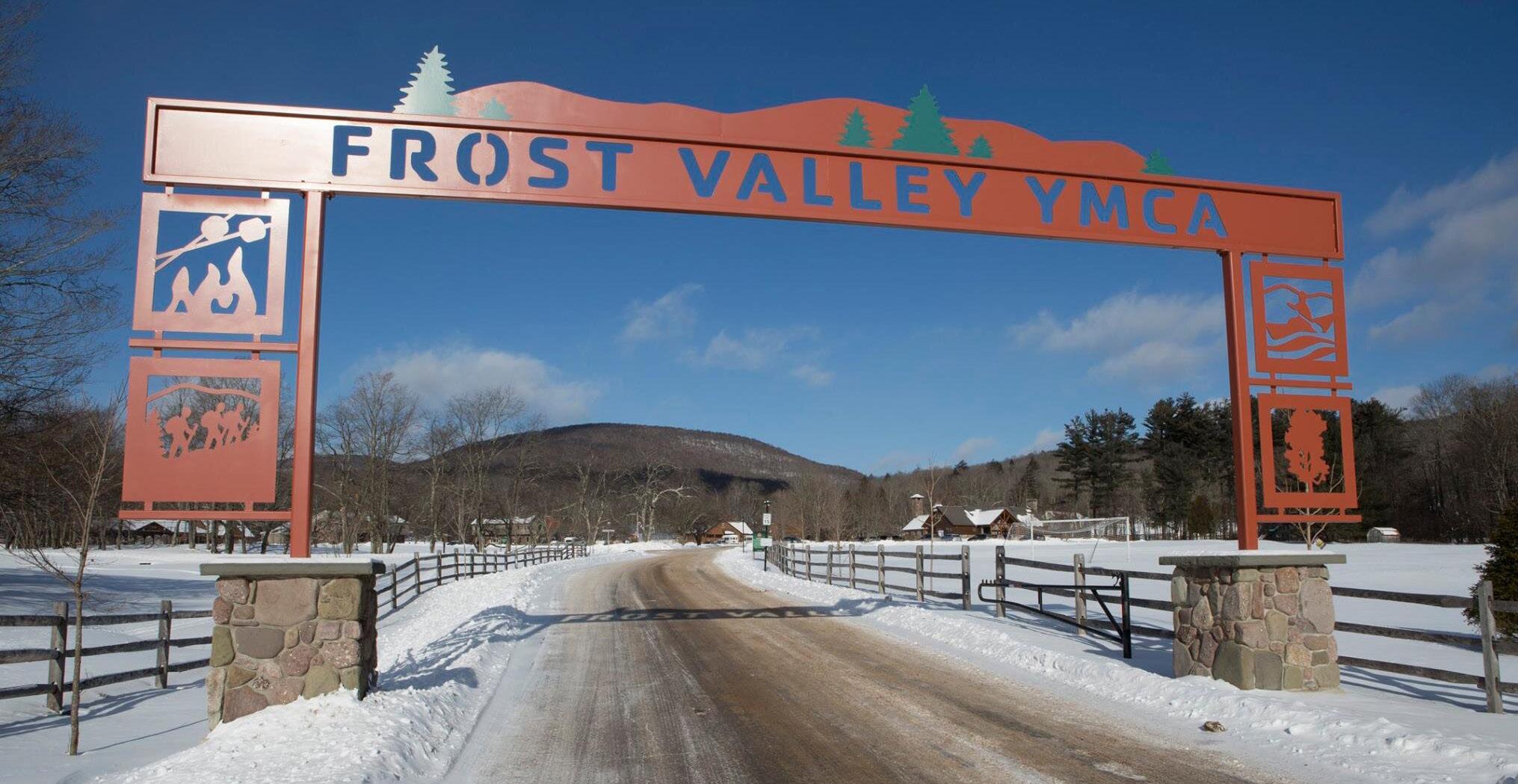 BEATRICE OLDEROG is a sophomore at Acton Academy Verona High School and a parishioner at Saint Mary Magdalene Orthodox Church in New York City.
BEATRICE OLDEROG is a sophomore at Acton Academy Verona High School and a parishioner at Saint Mary Magdalene Orthodox Church in New York City.
15 jacob's well
A Unity of Vision
A TRIBUTE TO DR. ALBERT RABOTEAU

argued persuasively that those Christian slaves were part of the suffering church. In other words, he said, they mystically took to heart St. Paul’s words about completing the sufferings of Christ.
Inspired to scour the internet to learn more about him, I found that he was a professor of religion at Princeton University. As it happened, I was then applying to a doctoral program in modern architecture at Princeton. Some months later, I was accepted at the school, and I moved to the Princeton area in the fall of 2008.
by DOYIN TERIBA
H"ave you heard about Albert Raboteau?” a friend asked me after Divine Liturgy. We were in the sanctuary at Holy Trinity, the Greek Orthodox cathedral on Manhattan’s Upper East Side. I was still wearing my cassock, basking in the afterglow of the service. Although the room was almost empty, it still felt full—as if the invisible members of the whole church were still there, even as the other parishioners had left for coffee hour.
I told my friend the name was unfamiliar.
“Here, take this,” he said, handing me a copy of Sorrowful Joy: A Spiritual Journey of an African American Man in Late Twentieth Century America, Dr. Albert Raboteau’s spiritual autobiography. It narrates how Dr. Raboteau, who was born into a Catholic family on the Mississippi Gulf Coast and became a pathbreaking scholar in the field of African American religion, came to embrace the Orthodox Church midway through his life.
Over the next few days, I devoured the book. I was spellbound by his telling of the stories of enslaved people in this country who became Christians during their bondage. It was as if I could hear the slaves’ voices. Dr. Raboteau—or Panteleimon, as he was known in the church—
After getting acquainted, Panteleimon soon became a third father to me—after my biological father (in Nigeria) and Fr. Daniel Skvir, the priest at Holy Transfiguration Chapel in Princeton, where I became a parishioner. Over the next several years, during my most difficult times at Princeton, Panteleimon was a stalwart for me. He comforted me when my mother passed away, while I was writing my dissertation. “My mother passed away too, before I completed mine,” I remember him saying. “I went to her funeral and then returned to finish it.” Those words gave me the strength to continue. In other moments of distress, he would sit with me at the Frist Campus Center, Princeton’s student union building, and listen to my concerns. When I spoke of wanting a “big, juicy” academic position after I finished my degree, he’d remind me to focus instead on the joy of learning, and to find topics I loved.
Panteleimon had great love for others, despite the harm that had been inflicted on him. I heard him speak at least twice, in public presentations, about how he never met his own father, who was murdered by a white man months before he was born. Panteleimon was forthright about his personal struggles. I admired his commitment to repentance and his willingness to always return to God. It explained his patience and gentleness with me.
As he explains in Sorrowful Joy, he was a devoted Roman Catholic for much of his life. He attended college at Loyola University, a Jesuit school in Los Angeles. The Jesuits' stated mission is to “find God in all things,” and the lessons he learned from his professors clearly stayed with him for the rest of his life. They spoke of a “unity of vision,” he wrote, wherein all human knowledge and experience fit into a pattern of meaning that we rarely glimpse. “At the core, tying everything
jacob's well 16
together, we learned, was a simple and yet profound belief: the insatiable desire of the human spirit for knowledge is an expression of our profound yearning for the infinite reality of God.” It was at Loyola that he was inspired to become a teacher.
Over the next several decades, he became a towering figure in the academic world. His 1978 book, Slave Religion: The “Invisible Institution” in the Antebellum South, remains the definitive study of the spiritual lives of America’s enslaved people. Its impact has been incalculable; it has inspired works in history, sociology, and literature, as well as in Panteleimon’s own field of religious studies.
His conversion to Orthodoxy took place in the 1990s, following a painful divorce. Sorrowful Joy describes profound experiences he had in churches, at a monastery, and at an exhibit of Orthodox iconography at the Princeton Art Museum, all while he was still an inquirer. He was most moved by the hymns he encountered in services. “They had the same sadly joyful tone which I associated with down home and with slave spirituals,” he wrote. After his chrismation at SS. Peter and Paul in Manville, NJ, he played a central role in establishing Mother of God, Joy of All Who Sorrow Orthodox Church in Princeton.
The sense of unity between his scholarship and his faith is remarkable. In Slave Religion, for instance, there are passages that resonate deeply with Eastern Christian theology—which is even more striking because he had not yet joined the Orthodox Church when he wrote it. He argues, for instance, that when enslaved people sang hymns like “Go Down Moses”—which describes the Hebrews’ exodus from Egypt, with the refrain “let my people go”—it was a form of liturgical, sacramental worship. A “sense of sacred time operated,” he wrote, echoing the scholar Lawrence Levine, “in which the present was extended backwards so that characters, scenes, and events from the Old and New Testaments became dramatically alive and present.”
It’s not hard to see a connection with the Orthodox services—for instance, those of Holy Thursday and Friday, in which we mystically partake in the Last Supper and the crucifixion of Christ. “During the Liturgy,” the theologian Paul Evdokimov wrote in 1959, “through its divine power, we are projected to the point where eternity cuts across time, and at this point we become true contemporaries with the events which we commemorate.”
The integrity between his professional life and his faith was also reflected in other ways. Like his patron saint, the third-century martyr, Panteleimon was a healer. He infused his academic discipline with Christian virtues, such as the recognition of the dignity of every human being—grounded in the understanding that each person bears the image of Christ. He exemplified what it means to be a scholar: He knew that if he could pose the right question, it would usually lead to collaborations with others who had expertise that he lacked. He had a knack for bringing scholars together and creating a collegial atmosphere, not unlike the Body of Christ.
Panteleimon was also a master teacher—a teacher’s teacher. He told me once that teaching a seminar was like breaking open the “bread” of the texts that he and the students read. I would venture to guess that from his perspective, the professor and the priest were one. Each invites people to share the joys of being in the kingdom through God’s creation, which is offered to God in thanksgiving. The professor knows that everything is sacred, and that to “break” open a text is to be reminded of that more permanent world where all things will be glorified and transfigured by the One Who Is.
When Panteleimon retired in 2013, Princeton University convened a conference in his honor, and scholars came from around the world. One former student called him “Saint Al,” recalling his gentle and caring mentorship and sweet demeanor. Another, who now teaches at Princeton, recalled receiving a “happy birthday” phone call each year from Panteleimon, who shared the same birthday. As a member of the Princeton Georgian Choir, I had the honor of serenading him with Georgian polyphonic songs during a reception.
He fell asleep in the Lord at the age of 78 in the fall of 2021, after suffering for several years from Lewy body dementia. He was laid to rest at the church in Princeton that he helped establish.
Thank you, Panteleimon, for being my third father. Thank you, Panteleimon, for showing me what a true Christian scholar should be. Thank you, Panteleimon, and pray for us.
17 jacob's well
ADEDOYIN TERIBA is an assistant professor of art history at Dartmouth University. He is a tonsured reader at Holy Resurrection Orthodox Church in Claremont, New Hampshire.
In Praise of Dissonance
REFLECTIONS ON STABILITY, HARMONY, AND TRADITION
by BENEDICT & TALIA SHEEHAN
On November 7, 1940, the Tacoma Narrows Bridge failed spectacularly. That morning, only four months after it had opened, the structure started shaking in the hard wind. Drivers felt their cars sliding around and heard the structure cracking; they barely had enough time to clamber out and sprint to safety. Within minutes, the bridge had collapsed into the Puget Sound.
On the morning of June 10, 2000, the London Millennium Footbridge was opened to the public, and just a few hours later, it started doing the same thing. The builders were forced to close the bridge that same day, and it needed two years’ worth of redesigning and rebuilding before it was safe for regular traffic. What was going on in both cases was a phenomenon known to physicists and engineers as harmonic resonance. Small vibrations within the structures, caused by wind or by ordinary traffic, effectively started echoing themselves— quite literally harmonizing with themselves—doubling in amplitude with each vibration and creating an exponentially increasing wave of resonance that the materials and construction techniques of the bridges were eventually unable to withstand. Essentially, the two bridges fell victim to their own internal alignment.
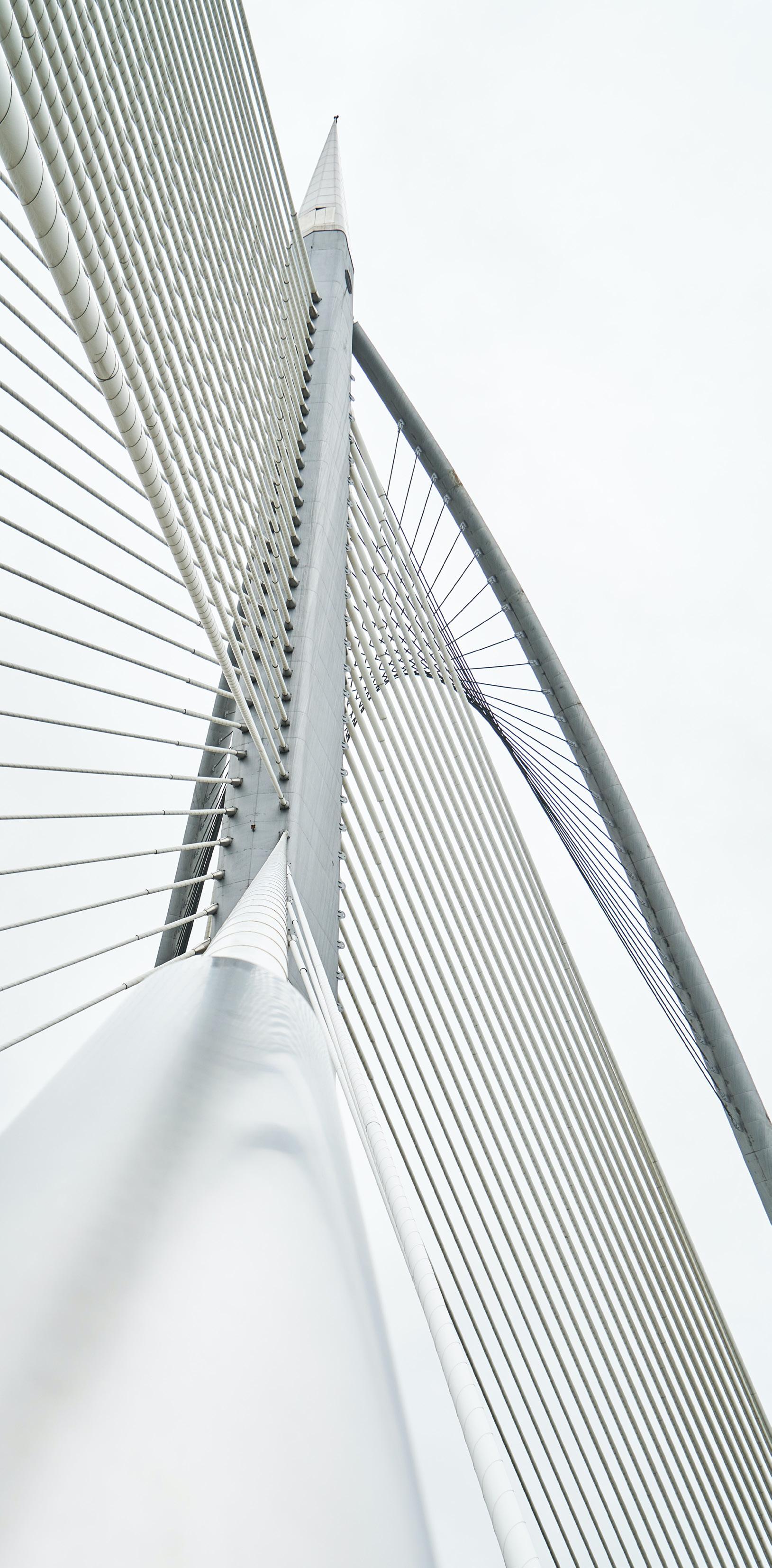
jacob's well 18
Engineers need to account for harmonic resonance in their structural designs. And the way they account for it is somewhat counter-intuitive. They prevent harmonic resonance by strategically introducing interference—essentially, by creating dissonance within the structure—so that small vibrations don’t infinitely echo themselves. For the two of us, as lifelong musicians, there is a fascinating parallel with what we’ve experienced in our own work.
In music, and especially in vocal technique, harmonic resonance is generally regarded as a good thing. It naturally amplifies sound while at the same time decreasing the amount of energy needed to produce that sound. However, in suspension bridges—or in microphone feedback, tsunamis, or earthquakes—harmonic resonance turns out to be a bad thing, sometimes catastrophically bad. In any dynamic structure that is constantly subjected to subtle changes in its environment—whether it’s a bridge, a building, an ocean, or a network of continental plates—interference is crucial. Dissonance saves the day. Without it, the structure will vibrate with those environmental changes and will amplify its reaction to those vibrations until it shakes itself to pieces.
So yes, harmony is good, but exclusively harmony turns out to be destructive. Every experienced musician instinctively understands this. Music without dissonance isn’t stable, either in its internal structure or in terms of its ability to connect with people and maintain a devoted audience for itself. In musical terms, dissonance may be broadly defined as a set of one or more pitches in which either the fundamental tones or their accompanying overtones interfere with one another in some way. Consonances—or tones that “harmonize” with one another (in popular terminology)—are, by contrast, sets of one or more pitches that align with one another and thereby create harmonic resonance. (And in case you’re wondering, yes, the traditional
consonances, such as unisons, octaves, and perfect fifths, do create more resonance than intervals that are considered dissonant.)
In any given piece of music, it is the interplay between consonance and dissonance, the dance between tension and resolution, that creates movement and gives music its sense of direction and meaning. Without dissonance, music simply doesn’t move—and, by extension, doesn’t really move its listeners. Though exclusively consonant music may appear, at least in theory, to have a kind of monolithic stability on the small scale, it risks its stability on the large scale by coming across as rather obtuse and meaningless, and thus becoming music that no one cares to listen to or remember in the long term. Musical stability, therefore, is a product of tension, a product of oscillation between the static and the dynamic, between the harmonious and the dissonant.
Even in the material world, stability is not fixed and unmoving. In our universe, it is achieved not by restricting movement but by allowing for it. Movement is the fundamental characteristic of existence. All molecules move or vibrate at the atomic and subatomic levels. All organisms maintain homeostasis by moving through intakeoutput and rest-effort cycles. All stable planetary orbital positions are examples of objects in constant, dizzying, high-speed motion. Like a bird balancing on a wire, stability is attained through continuous small-scale movement. Yes, excessive movement is destabilizing. But too little movement is just as destabilizing.
Human communities and institutions, especially religious ones, operate in much the same way. When there’s too much ideological alignment within an institution or community, too much inherent consensus, too much similarity of perspective, ideas and behaviors tend to amplify themselves in a cycle that looks a lot like harmonic resonance. Without a little calculated interference, a little strategic dissonance, that cycle can quickly
19 jacob's well
spiral out of control. It’s no accident that so many cults end up self-destructing in a blazing inferno or in a shoot-out with the FBI, or that so many governments that attempt to realize a vision of perfect alignment within the body politic end up committing atrocities. The best safeguard against catastrophic harmonic resonance within human society is for there to be deliberate and routine interaction with ideas, perspectives, and experiences that differ from one’s own. Essentially, human society needs dissonance to maintain stability.
Within Orthodoxy, as well as in many Catholic circles, today we see a deep commitment to the idea of tradition. An enormous amount of the rhetoric surrounding Orthodoxy, and especially modern conversion to Orthodoxy, involves words like ancient, original, historic, pure, apostolic, or unaltered, and our concept of tradition tends to be heavily colored by such associations. Many Orthodox believers today seem to have constructed an image of tradition as, essentially, a perfect harmony without dissonance. Thus, when they encounter dissonance of some kind within the church— whether in the form of opposing perspectives, beliefs, or modes of behavior, or simply in the form of doubt, questioning, or criticism—they tend to assume that the dissonance needs to be eliminated, that the opposition must be silenced, and that alignment needs to be reasserted at all costs, lest the harmony of the tradition be damaged. However, anyone who has undertaken even a cursory study of church history will probably suspect that such a picture of a changeless, unbroken harmony doesn’t quite match up with the facts on the ground. With a little more serious study, one begins to suspect that any notion of perfect harmony whatsoever is difficult to maintain without some serious editing of the historical record.
What if conflict isn’t necessarily a problem?

What if, instead of thinking of tradition as unadulterated harmony and consonance, we thought of it rather as something in a state of constant motion—continuously oscillating between stasis and dynamism, between maintenance and innovation, between harmony and dissonance? And what if, instead of regarding dissonance within
tradition as a threat to stability, we saw it as an essential saving grace, guarding tradition against the danger of catastrophic harmonic resonance?
In our work as musicians, as well as in our life experience more generally, we have found that if we care about something and want it to be stable and continuous over the long term, we need both to support it and challenge it. We have found again and again that we’re only able to create stability by allowing interference, and even by sometimes deliberately introducing dissonance to mix things up a little bit. Yes, we are aiming for harmony and alignment most of the time. But if we allow ourselves to fall into moving only in a predictable, consonant, regular way, we find again and again that our movement tends to amplify itself and cause destructive resonance.
If we want bridges to safely carry us over long expanses of empty space, they need to have dissonance built into their structures. If we want music to retain our attention and interest, to move us and inspire us, we need to value dissonance as much as harmony. We need to not let ourselves fall into the trap of thinking that only harmony creates stability. Likewise, if we want our traditions to be maintained, to continue over the long term, to offer us a home, to connect us to God and to one another, those traditions need to allow for, and even welcome, dissonance.
BENEDICT SHEEHAN , a two-time Grammy nominee, is the Artistic Director and Founder of Artefact Ensemble and the Saint Tikhon Choir. His music has been commissioned and performed by many of the world’s leading vocal ensembles, including Skylark, Conspirare, the Houston Chamber Choir, Cappella Romana, and the BBC Singers. He is an artist in residence at St. Tikhon’s Monastery.
TALIA SHEEHAN is the co-founder and Program Director of Artefact Institute. She has appeared with noted ensembles Cappella Romana, the Saint Tikhon Choir, and PaTRAM Institute Singers. She teaches voice, music theory, and liturgical music, and directs three children’s choirs and a women’s choir at St. Tikhon’s Monastery.
jacob's well 20

21 jacob's well
War as a Challenge for the Christian Vision
CHRISTIAN HARMONY AND DISCORD IN TIME OF WAR
by SERGEI CHAPNIN AND PRESBYTER MATTHEW BROWN
How should we as Orthodox Christians respond to violence? More specifically, to what extent, if any, should we support and justify violence? Is this ever necessary or even permissible?
Since the outbreak of war in Ukraine 18 months ago, many of us in the Church have found these questions inescapable. They’ve produced everwidening rifts in the global Orthodox world. All told, the emergent responses could be grouped into three major camps. They are:
1. We should just pray for peace,
2. This war is justified, and
3. God has condemned any use of violence.
Is one of these positions the “right” Orthodox position? Is that even the right way to frame this moral problem? We will examine each one of these positions and see whether any of them can be supported by our tradition.
1. We should just pray for peace
It’s not uncommon to hear the statement, “The Church should not be involved in politics.” Since the start of the war in Ukraine, it’s been amplified among some circles of hierarchs and clergy. Something like this is said: “We do not need to understand the political reasons for this war. Our task as Orthodox Christians is to pray for peace.” To this end, prayers for peace were composed in several local Orthodox Churches shortly after the Russian invasion began. Both the Russian Orthodox Church and the Orthodox Church in America prescribed these prayers to be recited each at the end of each liturgy, as well as in special petitions in the Litany of Supplication.
However, in the case of the Russian Orthodox Church, it’s safe to say that these prayers, to put it amicably, have been part of a public relations effort on behalf of the Kremlin. They’re clearly not politically neutral; instead, they exploit the
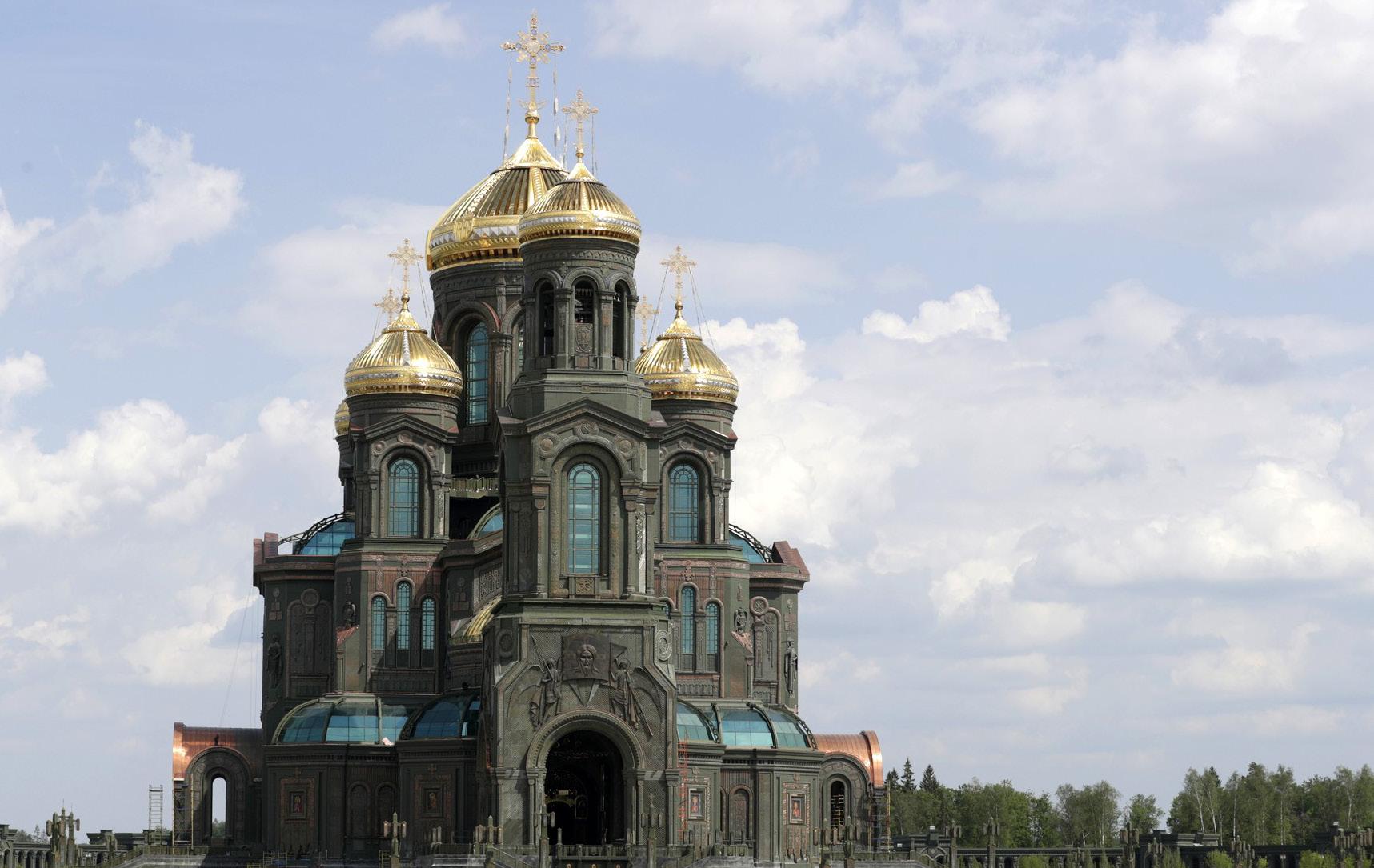
jacob's well 22
Main Cathedral of the Russian Armed Forces Courtesy of Wikimedia Commons
natural desire for peacemaking that many Christians share. They’re like an ideological parasite on a theological host.
Take, for example, what is now commonly being called the “prayer of Patriarch Kirill” which neatly aligns with the current ideology coming out of the Kremlin:
“From the one baptismal font at the time of the holy Prince Vladimir, we your children have received grace— establish a spirit of brotherly love and peace in our hearts forever! To the foreign nations who would seek to fight and to attack Holy Rus', forbid and overthrow their designs.” 1
The first takeaway, then, is that we should beware of those who would use prayer and peacemaking as cover for ideology. Prayer, when co-opted for an ideological purpose, can be used to halt any judgment of moral culpability, as well as for the starting, escalation, and prolonging of a war. It can stifle us from making moral judgments about the parties responsible for driving the conflict, and no party foreign or domestic is free from such responsibility. Prayer must accompany and strengthen the church’s prophetic voice to call all the worldly powers involved into this conflict to account.
The truth is that this prayer and much of the rhetoric associated with it ignore the reality of Ukrainian cities and towns being decimated by Russian missiles, thousands of civilians being killed, and tens of thousands of Ukrainian children being kidnapped to Russia, not to mention hundreds of thousands of young Russian men dead or injured. Can this behavior of the Russian government—and the Russian Orthodox Church that supports the war—be called brotherly love? Is this what genuine desire for peace looks like?
This brings us to another question. Suppose the admonitions to “only pray for peace” are sincere. In that case, what are we to make of them?
On one level, prayer alone is not sufficient. We are also called to moral action as Christians. Think of Christ’s parable of Lazarus and the rich man, found in the Gospel of Luke. The rich man encounters Lazarus, a beggar, lying at his gate. He ignores him, not even
offering him scraps. If he had prayed for Lazarus, this still wouldn’t have been enough. It wouldn’t have conformed to Christ’s instructions about how to treat “the least of these.”
In the same way, praying for peace cannot be a substitute for right action, but rather a constant companion on the road of working for peace. This doesn’t mean the Church needs to involve itself in political negotiations (although it has sometimes played a valuable role in that arena). But it does mean Christians should creatively consider how they might help. The work of Dr. Paul Gavrilyuk and his team at Rebuild Ukraine, who deliver aid to suffering Ukrainians, is one possible model.
The more difficult question is what we mean by “peace.” Should we be praying simply for violence to stop? Or does a Christian vision of peace demand more than this?
If we examine the Paschal hymns, we see that Christ’s action on the cross, His harrowing of hades, and His resurrection are all cast in the poetic language of conflict. Christianity is not a faith that avoids conflict; rather, it redirects it towards the true enemy: sin, the Devil, and death. These are the “principalities and powers of darkness” that St. Paul speaks of. The appropriateness of violence is another subject, but as to whether conflict is ever justified, the answer is a resounding yes. Real, lasting peace is not a mere ceasefire, but a just resolution.
In many wars—and the conflict in Ukraine is no exception—it’s easy to imagine a version of “peace” that simply amounts to the stronger party indefinitely suppressing the weaker one. From a Christian moral standpoint, this is not enough. This is the third lesson we can draw regarding the “pray for peace” position: there is no true peace without justice.
2. This war is justified
In any given conflict, it’s common for Christians to adopt some version of the just-war theory. For many, this position isn’t the result of rigorous theological engagement; it’s simply the idea that any violence
1 “Circular Letter of Metropolitan Dionysius of Voskresensk on Prayer for the Restoration of Peace,” Moscow Patriarchate, March 3, 2022, http://www.patriarchia.ru/db/text/5905833.html.
23 jacob's well
committed by their own side is justified in the eyes of God—that their hands are clean. This position has been widely adopted on both sides of the RussiaUkraine war.
The just-war theory in a primitive form was first articulated by St. Augustine of Hippo in the fifth century and later refined by Thomas Aquinas in the thirteenth century. In his essay, “Against Faustus the Manichean,” Augustine asks the question, “What is sinful about war?” He answers in this way:
“The real evils in war are love of violence, revengeful cruelty, fierce and implacable enmity, wild resistance, and the lust of power, and such like; and it is generally to punish these things, when force is required to inflict the punishment, that, in obedience to God or some lawful authority, good men undertake wars, when they find themselves in such a position as regards the conduct of human affairs, that right conduct requires them to act, or to make others act in this way.”2
One might see this position reflected in the prayer of the Orthodox Church in Ukraine:
“By Your might strengthen our godly people, bless their deeds, increase their glory with victory over the enemy, strengthen our state with Your almighty right hand, preserve the army, send Your angel to strengthen the defenders of our people, give us all that we ask for salvation; reconcile enmity and establish peace.”3
This prayer is not merely asking for an unspecified peace; rather, it is asking for a peace achieved through victory—as victory is seen as a necessary and justified step toward lasting peace.
But we should ask, what exactly is the standing of the “just-war theory” in the Orthodox tradition?
A lucid answer can be found in For the Life of the World: Toward a Social Ethos of the Orthodox Church, a document issued by the Ecumenical Patriarchate in 2020. It says:
2 Aurelius Augustinus, Contra Faustum Manichaeum, XXII.74
“The Orthodox Church has also never developed any kind of ‘Just-War Theory’ that seeks in advance, and under a set of abstract principles, to justify and morally endorse a state’s use of violence when a set of general criteria are met. Indeed, it could never refer to war as ‘holy’ or ‘just’. Instead, the Church has merely recognized the inescapably tragic reality that sin sometimes requires a heart-breaking choice between allowing violence to continue or employing force to bring that violence to an end, even though it never ceases to pray for peace, and even though it knows that the use of coercive force is always a morally imperfect response to any situation. … Christian conscience must always reign supreme over the imperatives of national interests.”4
The just-war position can easily become a fiction to justify actions that are unjust. It can also lead Christians to believe that in cases where violence is necessary, their own hands are clean and their souls free of any culpability. No such pristine position exists. Self-righteousness and the proliferation of violence are real dangers of this position, as is blindness to one’s own moral failures committed during a time of war for which an individual or entire people must repent of, and make recompense for.
3. God has condemned any violence
Finally, there are those who believe Christian peace precludes any kind of violence. This position is perennial in the Orthodox tradition. Christian theologians from the pre-Imperial age of the Church can easily be cited in support of this position. Take Tertullian’s brief but capacious formula, written in the second or third century:
“For albeit soldiers had come unto John and had received the formula of their rule; albeit, likewise, a centurion had believed; still the Lord afterward, in disarming Peter, unbelted every soldier.”5
This opposition to state-sponsored violence, however, is not restricted to the pre-Imperial age. It can also be seen in St. Ambrose’s standoff with Emperor Theodosius in 390. That conflict began when Emperor Theodosius
3 “Prayer when the Motherland is in danger,” Ukrainian Orthodox Church, January 29, 2022, https://www.pomisna.info/uk/vsi-novyny/ osoblyvi-molytvy-za-ukrayinu/.
4 “For the Life of the World: Toward a Social Ethos of the Orthodox Church,” Greek Orthodox Archdiocese of America, March 27, 2020, https://www.goarch.org/social-ethos.
5 Tertullian, On Idolatry, 19.
jacob's well 24
ordered the murder of 7,000 citizens of Thessalonica at the city's hippodrome. When the emperor went to the liturgy in the cathedral, St. Ambrose did not let him even into the narthex of the church. St. Ambrose excommunicated the emperor for eight months, and the emperor accepted this penance. He entered the church and received communion only on Christmas in the year 391.
However, despite these precedents, pacifism has not been the prevailing position in the Orthodox tradition. Christian pacifism is a kind of maximalism, and it’s hard to make this position work in an absolute way while being faithful to our tradition. An inflexible and absolutist ethic is rarely found among the writings of the saints. It is more common among rigorists and schismatics, such as the Novatians, a sect that existed from late antiquity until the eighth century, who believed that any fellow Christians who betrayed the faith under threat of persecution should not be readmitted into the church.
What distinguishes this approach from the rest of tradition, given that we regularly venerate martyrs and passion-bearers who willingly sacrificed their own lives? The difference is that most Church fathers and martyrs have not called for an absolutist standard of pacifism, one that is binding upon all Christians for all times—though it ought be stated that even if our tradition has not unequivocally adopted a pacifist ethic, it has certainly adopted an ethic of peace and strong skepticism towards war.
Moreover, we must be careful about espousing pacifism from our comfortable position in the West, far removed from the devastation in Ukraine, insulated from the difficult personal choices that people have to confront in the face of violence against those dearest to them. To condemn all violence when we’re not in the position of having to accept martyrdom is not necessarily virtuous. These moral questions have a personal dimension that shouldn’t be ignored.
How, then, should we respond?
First, we should recognize that an easy and tidy response is not readily at hand—and that to think otherwise is dangerous. Second, we can safely say that mere prayer is not enough. If our prayers never touch the rest of
our lives and shape our actions, what kind of prayer is that anyway? Third, we should be cautious about declaring any war just. Declarations like these can easily lead to defending atrocities. Wars are complex, and in some cases, military actions that are justifiable can be used as a smoke screen for defending actions that are reprehensible. However, we also need to accept that sometimes ethically imperfect options are the only ones we have. In those cases, we still must repent and make amends for our choices—even if those choices were in large part handed to us by the circumstances.
Finally, we should recognize that absolutist ethics such as pacifism tend to oversimplify complex problems. They overlook the personal dimensions of moral choices, and ignore the moral burdens placed upon each of us to discern what is good in each situation. In some areas, the question of what is right does not come down to a single rule that applies in every situation. Further, such absolutist ethics are an easy temptation for those who don’t have to contend with its costs.
All this is to say that there’s no perfect answer. Unfortunately, to give some kind of step-by-step instruction on how to be the most Orthodox regarding the war in Ukraine would be misguided. At this point perhaps the best we can do is identify moral and intellectual pitfalls. This is more of a negative ethic like negative, or apophatic, theology. The ethical life of a Christian is always this way: it requires us, individually and together, to discern in an ongoing way what seems to be the most Christ-like path in the context of a fallen world. And the best way to do that might just be identifying all the wrong ways instead of the one right way.
SERGEI CHAPNIN is the director of communications at the Orthodox Christian Studies Center of Fordham University and chief editor of TheGifts(Дары), an almanac on contemporary Christian culture. He is a parishioner at the Church of Our Lady of Kazan in Sea Cliff, New York.
REV. MATTHEW BROWN is the editor-in-chief of Jacob’s Well. He is a PhD candidate at Fordham University and the rector of St. Mary Magdalene Orthodox Church in New York City.
25 jacob's well
Religiō as a Universal Human Quality
ON THE HARMONY OF FAITH TRADITIONS
by JESSE HAKE
Modern Christians slip easily into thinking that our faith is in competition with other religions. However, for most of Christian and pre-Christian history, it was widely understood that everyone shared a basic religious impulse and that this was a crucial human virtue, a capacity required for the exercise of our humanity across all aspects of human society. In the first millennium or more of the Christian faith, the various “religions” did not primarily vie with one another—as we tend to do—over claims to dogmatic truth or in earning the right to meet whatever “religious needs” they might have alongside more basic secular or public needs.
Premoderns generally agreed that all humans were religious beings who each needed to cultivate equally the virtue or skill of religiō (as it was called in Latin) within every zone of endeavor, leading to a fully connected and harmonious human life. Given these common goals, different wisdom and folklore traditions could share various aspects of life and learn from each other. Christians, with their universal claims that Jesus Christ is the revelation of the Godhead and of all truth, were best poised to gain insights into the meaning of Christ’s incarnation from the metaphysical and moral insights of other traditions. This is not to say that all traditions are in agreement, or that they are all equivalent paths to God, but it does provide a basis for Christians to seek the flourishing of every
city and to bring all truth, insight, and beauty into conversation and relationship with the revelation of God in Christ’s incarnation.
What was in competition for ancient faiths was not the various ideas or concepts (competing “beliefs” as we tend to think today) so much as the practices, habits, and material culture including the canons of sacred texts themselves and the stories surrounding the ancient teachers.1 All of these sacred practices from varying schools and sects, however, would have been understood as aiming to cultivate the same human virtue of religiō (along with other virtues such as wisdom).2 As with everything else in our modern world, religions have been commodified. They are largely reduced to sets of goods and services offered on the free market and regulated as neutrally as possible by the sovereign secular state. Christians must now lobby beside other faiths on behalf of our “religious rights” and consider what options will best care for any “religious needs” that we might have. Many or most religions have been reduced to just one more means of personal self-care.
Most of the modern categories of “world religions” were developed by scholars from European colonial powers who were influenced by ideas endemic to Christendom as well as by issues related to the end of Christendom and the rise of modernity, the secular nation state, and the autonomous individual. All religions came to be identified over against the realm of the secular,
1 Origen Against Plato by Mark J. Edwards (Aldershot, UK: Ashgate, 2002).
2 Many scholars have told these stories from a variety of perspectives about how the concept of “religions” or “the religious” was invented in the modern era. See The Invention of World Religions by Tomoko Masuzawa, The Meaning and End of Religion by Wilfred Cantwell Smith (with the most explicitly Christian framework of all those listed here), Before Religion: A History of a Modern Concept by Brent Nongbri, Imagine No Religion: How Modern Abstractions Hide Ancient Realities by Carlin A. Barton and Daniel Boyarin (focused more narrowly on the ancient and Hellenistic past), and 50 Great Myths About Religions by John Morreall and Tamara Sonn.
jacob's well 26
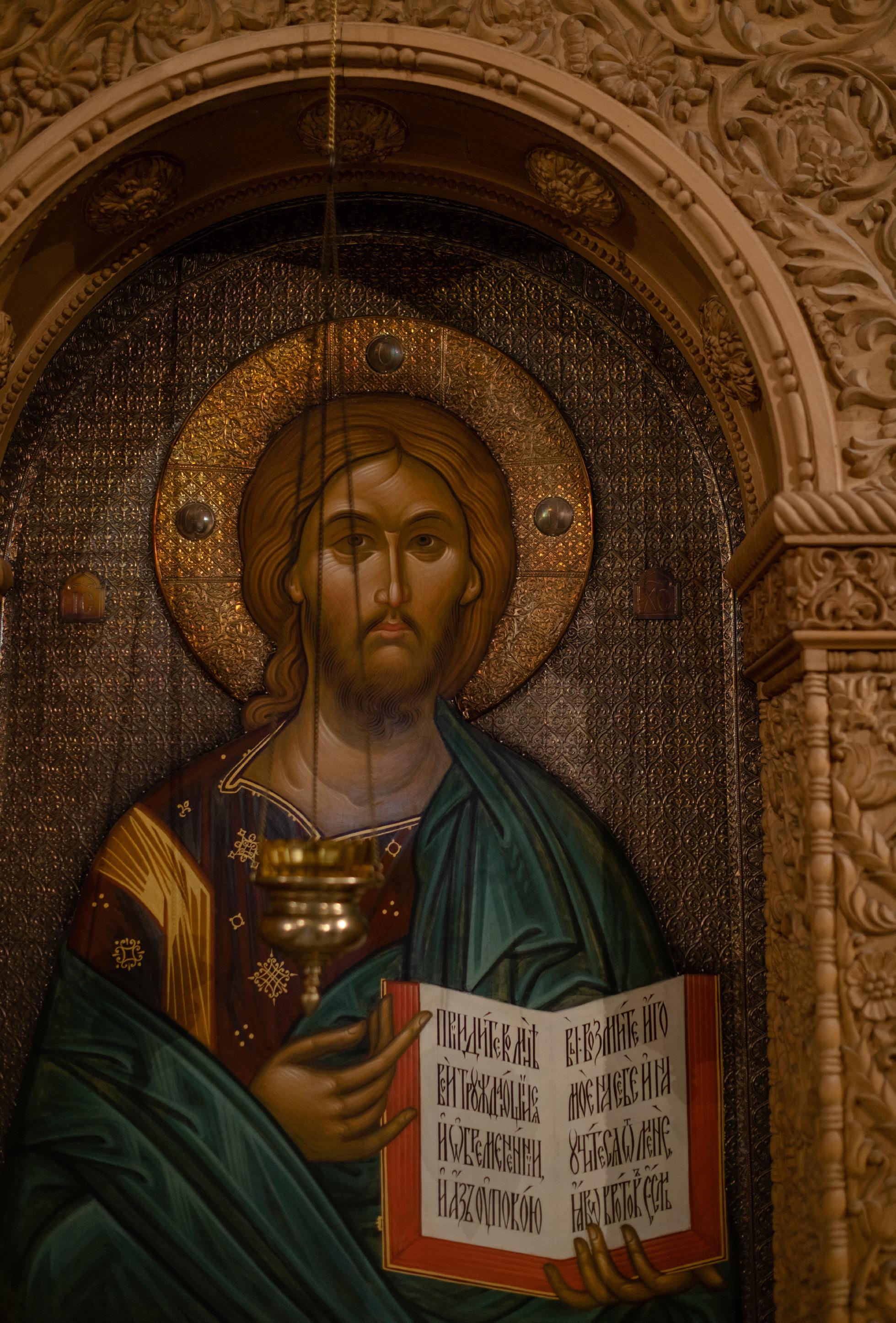
27 jacob's well
Photo: Ron Lach © Pexels.com
and many religions were invented as categories imposed rather artificially from the outside. Hinduism is one of the more obvious examples. When India was occupied by Great Britain, the wide range of philosophies and local folk religions that existed in the subcontinent did not consider themselves to be part of one faith community, but Hinduism was given as a catch-all name by the British colonial scholars. Ironically, despite these European origins, in more recent years, Hinduism has become a focal point for some modern forms of Indian nationalism. Similar trends have deeply reshaped our thinking about all world faiths including Christianity itself.
Before these modern developments, what was notable about the pre-modern understanding of religiō was that various philosophical schools and traditions of cultic practice could all aim at the cultivation of this same human virtue. Certainly, the teachers and sacred texts were in
is the best way to understand the subjugation of all cosmic principalities under Christ that Paul speaks about in several other letters as well. Finally, Paul’s injunction in Philippians 4:8 brings all of us into this task of recognizing and ordering the goodness and truth of Christ that is dispersed throughout creation and across all of history: “Whatever things are true, whatever things are noble, whatever things are just, whatever things are pure, whatever things are lovely, whatever things are of good report, if there is any virtue and if there is anything praiseworthy—meditate on these things.”
real competition—but the fact that they shared recognized common goals made it reasonable to also see that one school or cult could learn and benefit from others in various ways.
This was easily recognized by many early Christian writers. Justin Martyr's First Apology (written 155 to 157) says that Christ “is the Word of whom every race of men were partakers.” Church fathers widely agreed that Jesus Christ reveals the meaning of all history, all creation, and the entirety of God’s divine life. As Paul says in Colossians 2:9-10: “For in Him dwells all the fullness of the Godhead bodily; and you are complete in Him, who is the head of all principality and power.” Paul talks in the previous chapter about the ordering of all formerly hostile powers under the headship of Christ. This putting into order
Every human culture must call upon all of creation to participate in the exposition of what Jesus Christ has revealed. Whether it is Justin Martyr’s logos spermatikos or the logoi of all creatures that Maximus the Confessor wrote about five centuries later, Christians have received the most comprehensive revelation possible. Gregory of Nyssa points out in The Life of Moses that Christ is the manifestation of an infinite God and that union with God is therefore synonymous with an endless stretching out of our capacity to receive. In a related point, Dionysius the Areopagite expounds on how it is that every theophany of God must always be both a concealment and a manifestation at one and the same time (similarly to how one Greek word for truth, aletheia, describes the manifestation of a hidden reality). The more complete the divine revelation claimed by any school or sect, the more this school or sect must learn from other traditions of sacred wisdom about the profound revelation they themselves have received. It is counterintuitive to us, but the prevailing pre-modern view was that the deeper and the more universal the revelation, the more that everyone must participate in the full reception and unfolding of it.
This approach has not been entirely lost to modern Christians. One beautiful exploration of such a Christian vision is by the Orthodox Christian scholar Jaroslav Pelikan with his book, Jesus Through the Centuries: His Place in the History of Culture. Keith Harper noted of Pelikan’s book in a 2020 review: “As amazing as it might seem, the historical Jesus forges a common link for a host of unlikely fellows ranging from the Apostle Peter and Tertullian to David Hume and
jacob's well 28
"Every human culture must call upon all of creation to participate in the exposition of what Jesus Christ has revealed."
Thomas Jefferson.”3 Christians claim that the man Jesus Christ is the most perfect and most beautiful revelation of God the Father, and we should therefore consider if such a profound revelation of all truth should require generations of human wisdom from every culture, time, and place to fully comprehend and articulate it. Such a vision was once easily comprehensible but has faded from prominence among modern Christians and needs resuscitation.
We can look back at Christian history and see concrete examples of how Christianity came to better see and understand the incarnation of God in Jesus Christ with help from pagan schools of thought. Arguably, several New Testament authors had recourse to concepts from a popular Stoicism as they articulated what had been revealed in Jesus Christ. But possibly the most obvious example of this in later centuries is with the most prestigious school of pagan wisdom: neoplatonism. This school claimed that the world of our five senses is an icon of an even more substantial world and that our contemplative mind can participate in this more substantial world only when it is received in wonder as a gratuitous gift. A variety of thinkers have made the case that Christianity did not replace neoplatonism but instead learned from it and engulfed or engrafted it.4
All this also shows up in David Bentley Hart’s recent book, Tradition and Apocalypse: An Essay on the Future of Christian Belief. Hart appeals to today's Christians to recognize how our shared humanity as religious creatures should open us all up to the shared objective of learning to see the reality that is revealed to us by Jesus Christ from the kingdom of God (from a realm of truth that is more than history). Hart argues that other traditions of faith and wisdom can help Christians to more fully grasp the infinitely deep and transcendent meaning of Christ’s incarnation, death, resurrection, and ascension. This is not to say that all traditions are equivalent, or to make the glib claim that they all lead to God. It is to say, however, that Christians
can learn things about the revelation of Jesus Christ from the metaphysical and moral insights in other traditions of piety, faith, and wisdom. It should seem obvious, as well, that recognizing this is by far the most meaningful way in which to invite other faiths into conversation and relationship with us as Christians—recognizing our real differences of revelation, doctrine, and practice while also respecting, partnering, and learning from one another at the same time.
Several prominent examples in the New Testament suggest that such an idea is not at all alien to the methods of Christ or His apostles. Jesus uses a Samaritan as a model of righteousness (Luke 10) and commends a Roman centurion as having faith greater than any in Israel (Luke 7:9). In other passages, Christ is clearly focused on his immediate calling to the people of Israel, but He draws upon everything around Him when teaching about God’s Kingdom and what faithfulness to this kingdom means.
In a similar vein, the Apostle Paul famously quotes pagan poets and philosophers when engaging with the learned crowd gathered at the Areopagus in Athens (Acts 17). According to this model, Christians recognize the revelation of Jesus Christ as the most supremely beautiful, clarifying, and perfect manifestation of God at the center of our fallen history, and this comes with a real burden of both good news and confrontation. However, the way we learn to receive this revelation of Jesus Christ should not happen in isolation from the many strands of human experience—and certainly not in separation from all that is good, true, and beautiful within any realm of human experience.
While the fathers and mothers of the church expressed many concerns about pagan wisdom, there is also a tradition of interaction and borrowing that extends clearly back to the New Testament and even earlier into the Jewish faith from its earlier origins and up through the birth of Jesus Christ. St. Jerome speaks of these many pathways in his Homilies on the Psalms (homily 42 on Ps 127 or 128):
3 See this March 2000 review by Keith Harper in The History of American Religion (H-AmRel). (https://networks.h-net.org/ node/15697/reviews/15856/harper-pelikan-jesus-through-centuries-his-place-history-culture)
4 For example, Fr. Andrew Louth gave a lecture in January of 2021 entitled “The Necessity of Platonism for Christian Theology” and Hans Boersma wrote “All One in Christ: Why Christian Platonism Is Key to the Great Tradition” in February of 2020. In March of 2016, Brad Jersak wrote “Pushing Back: 'Greek Thinking' vs. 'Jewish Thinking' is a Dualistic Error” (the first chapter in The Gospel According to Hermes).
29 jacob's well
What are the marks of the man who fears the Lord? The stamp of those “Who walk in his ways.” There are many ways, and the many ways lead to the one Way, wherefore it says in Jeremiah: “Stand beside the ways of the Lord and ask for the eternal pathways; find the one way, and walk it.” ...Through many ways, we find the one Way. This same thought occurs in the Gospel under another form and figure in the parable of the merchant who had many pearls and sold them and bought a single pearl of great price.5
In more recent times, we can look to missionary examples, such as the work of St. Herman and his compatriots who settled in Alaska. These missionaries clearly followed in the example of Ss. Cyril and Methodius, who “sought to give every people-group access to the Scriptures and liturgy in their own language so that they may become part of ‘a privileged and chosen society within which every nation has its own peculiar gifts and every people its legitimate calling.’”6 The stories recounted in books such as The Transition from Shamanism to Russian Orthodoxy in Alaska by S. A. Mousalimas7 or Alaskan Missionary Spirituality by Michael J. Oleska8 show clear appreciation by the missionaries for what native Alaskans already understood about the goodness of creation and how this enabled the Aleuts and other peoples to see the reality of God incarnate in Jesus Christ and His Body, the Church.
Mousalimas describes the ministries of two shamans who were blessed by Orthodox churchmen: the Aleut elder of Akun, Ivan Smirennikov, as well as an Alutiiq healer named Kangatyuq. In the case of the healer Alutiiq, we have an account of St. Herman recognizing Alutiiq’s gifts as a shaman and inviting Alutiiq to heal the daughter of a priest who was deathly ill. In the second case, Smirennikov, a baptized Orthodox Christian, was being referred to as a “shaman” by the Akun Aleuts during a period
of over three decades. Upon looking personally into Smirennikov’s ministry, Bishop Innokentii (Veniaminov) differentiated Smirennikov’s ministry of healing and prophecy from shamanism but still gave his blessing to Smirennikov’s regular interactions with visiting spirits who provided healing and counsel to the people. The bishop encouraged the elder of Akun not only to continue practicing but to practice among the baptized Aleuts of his own parish.
Mousalimas also describes festivities known as Selaviq (or “Starring”) that are clearly a synthesis of “both the ancient Yup'ik and the Christian elements” so that: “These mid-winter Yup'ik Orthodox Christian ceremonial festivities ...contain unique characteristics that have been retained and transformed in continuity from Yup'ik antiquity. A creative synthesis has taken place.” This is all possible because the Russian Orthodox missionaries recognized the goodness of the “sacralized cosmos” already understood by the ancient Yup'ik cultures and that “the dynamics of divine participation” were also seen in the ancient Aleut and Alutiiq cultures who already “had the ability to comprehend the dynamics of ‘pantheistic divine participation in the cosmos’” before the arrival of Christian missionaries.
As Mousalimas and others studying Orthodox missionary history have also pointed out, such an understanding was widespread among the church fathers. Origen defends the pagan recognition of all nature as filled with living spirits:
We indeed also maintain with regard not only to the fruits of the earth, but to every flowing stream and every breath of air that the ground brings forth those things which are said to grow up naturally—that the water springs in fountains, and refreshes the earth with running streams—that the air is kept pure, and supports the life of those who breathe it, only in consequence of
5 The Homilies of Saint Jerome, Volume I (1-59 On the Psalms) translated by Sister Marie Liguori Ewald, I.H.M. (Washington, D.C.: The Catholic University of American Press, 1964) page 317.
6 “Missionary Schools and the Enlightenment of the Alaskan Natives: A Theological and Sociological Survey of Russian Orthodox and and Protestant Missionary Efforts Among the Nations of the Aleutian Islands and Southeastern Alaska” by Erik C. Young (Seminary Masters Theses for George Fox University, 2007) citing Dimitri Obolensky, “The Cyrillo-Methodian Mission: The Scriptural Foundations,” St. Vladimir's Theological Quarterly 30:2 (1986), 102.
7 Providence, RI: Berghahn Books, 1995
8 Yonkers, NY: St Vladimir's Seminary Press, 2nd edition, 2010
jacob's well 30
the agency and control of certain beings whom we may call invisible husbandmen and guardians; but we deny that those invisible agents are demons.9
Many Christian churches contained various pagan figures (such as sibyls) in the outer courts as the worshipers approached incrementally, through pagan and Old Testament wisdom, toward Christ Himself at the altar. Paganism was not understood as simply an evil or a falsehood to be rejected but as a gift containing essential help to Christians in their comprehension of God’s plentitude as revealed by Jesus Christ. Early Cumbrian Christians in the first half of the tenth century carved the stone Gosforth Cross and depicted the Norse goddess Sigyn symbolically alongside of Mary Magdalene at the foot of the cross. Sigyn is shown on this cross saving the life of her husband Loki (the trickster son of Oden) by holding a bowl over Loki’s head to catch the poison dripping toward him from the fangs of a snake that the other gods had sent to kill Loki. Clearly, these Christians understood that their older pagan stories had meaning that could help them to grasp the beauty revealed on the cross. To consider one more example, Orthodox Christians should not be embarrassed (or simply ignorant or amused) by the fact that an account of Buddha’s youth and enlightenment made its way into Christian tradition as the beloved story of Ss. Barlaam and Josaphat, who were entered into the Greek Orthodox liturgical calendar on August 26. Our increasingly secularized global civilization presents both a challenge and an opportunity when it comes to relating with people of other beliefs and practices. However, Orthodox Christianity should have the vision and the resources to provide local and global leadership in relation to religiō as a universal human capacity that we still possess despite our blindness to it. Whether reading about ancient folk practices in Cosmos, Life, and Liturgy in a Greek Orthodox Village by Juliet du Boulay10 or exploring the “sad joyfulness” of Black spirituals in Jubilation: Cultures of Sacred Music by Nun Katherine Weston,11 Orthodox Christians have every reason to recognize that human
experience is always fundamentally religious and that all of creation should enable us to more fully perceive and receive the revelation of Jesus Christ. As Maximus the Confessor writes: “The Word of God, very God, wills that the mystery of his Incarnation be actualized always and in all things” (Ambigua 7.22).
Orthodox Christians should be the first to hear and understand the voices among us such as Jaroslav Pelikan and David Bentley Hart (with books like Jesus Through the Centuries or Tradition and Apocalypse) as such Orthodox writers call us to see that “Christ plays in ten thousand places” (in the words of Gerard Manley Hopkins). We should be the warmest champions of our local communities and of their endless capacity for festivals and celebration. We should see that our Christian liturgical life is intended to spill over into the habits, rhythms, and frolics in all realms of life where they might still exist and be ready for attendance and encouragement. We should seek the flourishing of all our religious neighbors and cultivate hearts that are ready to learn from them how to better see the humanity that we have received in Jesus Christ.
If Orthodox Christians succumb to the commodification of religion and its modern colonial categorizations, then we miss out on countless opportunities to share Jesus Christ with the world while also, even more sadly, blinding ourselves to many of the ways in which other faiths might help us to see the reality and goodness revealed by Christ’s incarnation within human history. Our modern and commercialized way of seeing religion not only hollows out the richness of religion but puts us more and more into conflict with one another by seeing competing camps rather than the common duty of every human being and of all society to be religious and to cultivate that virtue.
11 Indianapolis, IN: Fellowship of St. Moses the Black, 2022
9 Contra Celsus 8.31.
10 Limni, Evia, Greece: Denise Harvey, 2009
31 jacob's well
JESSE HAKE is the director of ClassicalU.com and the former principal of Logos Academy in York, Pennsylvania. He is a parishioner at Holy Apostles Orthodox Church in Mechanicsburg, Pennsylvania.
Working with Discord to Facilitate Interpersonal Harmony
 by JOHN LIVICK-MOSES, LICSW
by JOHN LIVICK-MOSES, LICSW
Who among us doesn’t crave peace, harmony, and love in our lives and relationships? We all want to get along with our families, friends, and romantic partners. Yet, as the adage goes, ‘to err is human,’ and conflict is possible with any human connection. Most of our disagreements stem from miscommunication, incompatible expectations, or insensitive behavior. Even when we strive for harmony with the people close to us, we often find ourselves deeply entrenched in conflict.
The challenge I offer with this essay is this: Rather than fear or avoid conflict with others (which is common in my therapy sessions as a clinical practitioner), how can we encourage and embrace conflict as a normative and healthy part of life— which, if channeled correctly, can ultimately bring us greater peace and harmony? In other words, how can we use conflict in a healing capacity? Drawing on my professional experience as a therapist, I’d like to offer a few suggestions.
Steps for Finding Harmony within Disharmony and Discord in Our Relationships
1. Try to start from a place of curiosity in all interpersonal interactions, especially in situations of conflict. I can testify that the space within therapy is about confronting conflict. Yet it’s essential for my patients to look internally and externally at their lived experiences without a sense of judgment, approaching themselves and others more through the lens of objective curiosity. In our sessions, they often find it helpful when they can manage to set aside their emotions and truly ask: Why?
When we ask why, we may learn that our partners are not actually just mad that we did not do the dishes as asked. This creates the space for genuine empathy to take place. At this point, we can go back to our partners—or friends, or roommates, or siblings—and ask, “Why were you so upset I didn’t wash the dishes?” Perhaps they’ll say, “It makes me feel like you don’t care,” or “It gives me the sense that I’m not being taken care of.” I’ve seen many cases where the underlying fear or
motivation of one person has been hidden behind other issues amid conflict. By asking questions and maintaining empathetic curiosity, we may realize the presence of a more profound pain.
The best fiction is geared towards conflict. We learn most about our characters through tension when they are put up against insurmountable obstacles. This is true in real life. –
Sufjan Stevens
2. We must become unafraid of humility. We need to accept our weaknesses and the failings of ourselves and others. St. Paul speaks about this in Romans 7:15-20:
For what I am doing, I do not understand. What I will do, that I do not practice; but what I hate, that I do. If I do what I will not do, I agree with the law that it is good. But now, it is no longer I who do it, but sin that dwells in me. For I know that in me (that is, in my flesh) nothing good dwells; for to will is present with me, but how to perform what is good I do not find. For the good that I will do, I do not do; but the evil I will not do, that I practice. Now if I do what I will not do, it is no longer I who do it, but sin that dwells in me.
This describes a frame of mind that we all need to pursue. True humility unravels the authentic truth about who we are as human beings. By accepting ourselves as we really are, and not how we would like others to think about us, we can begin to repair broken parts of ourselves and our relationships. Therapy works the same way. As a counselor, I actively work with people to help unravel those things which push them to act, feel, or experience things that they otherwise don’t want to, i.e., depression, anxiety, anger, trauma responses, and so on.
Humility requires us to accept the idea that we might be deeply broken, and that we have spiritual and mental-health concerns that are vastly beyond our control. However, we know the prize that comes with this kind of radical acceptance and embracing of disharmonious selves. It testifies to one of God’s most remarkable and distinct promises in the Scriptures: “God opposes the proud,
33 jacob's well
Pensive (1937-1938) Mikuláš Galanda
but gives grace to the humble” (James 4:6). Our best model here is Christ, whose entire life was an extreme act of humility—from His incarnation to His death and resurrection.
The value of humility is also widely recognized in the psychotherapeutic world. In fact, there is an entire school of clinical practice, known as Dialectical Behavioral Practice (DBT), that I often use with my own patients. DBT is an evidence-based treatment that focuses on changing behavioral patterns, especially within interpersonal conflicts. It can help destigmatize our faults through the practice of ‘radical self-acceptance.’ It often involves prayer, mindfulness techniques, and emotional regulation skills—tools that we also find in the Orthodox spiritual tradition.
Discomfort in Interpersonal Conflict
3. Practice sitting in discomfort, which is the path to true harmony. Embrace it. Be warned, however, that doing this kind of internal work, whether personal or interpersonal, can often be painful.
Often, couples have told me in therapy sessions that they’re afraid to let their children witness their fights. They worry that if their kids see them ‘fail’ in their communication with each other, the kids might be irreparably damaged. I challenge this idea. It is equally important for children’s development to see how we repair our conflicts after they occur. Sure, children might be hurt in some way when they see their parents fight, but they can also learn invaluable lessons by seeing their parents returning to each other and embracing in love, despite their failures or weaknesses. When we allow our kids to witness healthy ways of coping with difficulty,
we provide examples of what it means to truly live the Gospel in your lives. “Bear with each other and forgive one another if any of you has a grievance against someone. Forgive as the Lord forgave you” (Colossians 3:13).
The Ego in Relationships
Conflict forces us to be fully present because it shatters our ego—stripping away all hope of escape or sugarcoating. It removes everything nonessential to our authentic being. It removes all superficial layers. Conflict is painful because it wakes us up out of our created illusions. And if we lean into it, conflict can be the catalyst to our enlightenment. – Alaric Hutchinson
4. Finally, confront the Ego. Keep in mind that the Ego—the base part of our psychology, which helps mediate conflicting desires in discernment—is essentially good. It’s given to us by God, and it’s necessary for our survival as a species. As creatures who were made in the image and likeness of the God who is Love, we are also beings of love. This means that the work of the Ego, in all its behaviors, on a deeper level, is about love, connection, and ultimately oneness with others and God. Christ speaks to this truth during his time in the garden of Gethsemane:
That they may all be one; even as thou, Father, art in me, and I in thee, that they also may be in us: that the world may believe that thou didst send me. And the glory which thou hast given me I have given unto them; that they may be one, even as we are one; I in them, and thou in me, that they may be perfected into one (John 17: 21-23).
Is this not what real theosis and holiness are all about?
jacob's well 34
This theological truth is reaffirmed in clinical psychological practice. We see throughout psychological and therapeutic literature that the Ego is ultimately rooted in the need for love. This is the side of us that desires connection and interdependence with others and is distinct from ‘egotism.’ Egotism is rooted in pain and is wholly self-centered, driven by a misguided sense of either extreme superiority or inferiority.
If our goal as Christians is to achieve holiness, we need to be aware of what it means to ‘other’ another human being, especially the people closest to us. Othering can take many forms on both the macro and micro scales of human relationships. On the macro scale, this might look like racial profiling, labor exploration, slavery, and sexism. On the micro level, othering might look like mansplaining, yelling and screaming, and gaslighting. Certainly, we have seen the fruits of these forms of making ‘other’ those people whom we misunderstand or fear in history. We all know the pain that comes from these forms of othering, because we’ve all been on the receiving end, just as we’ve done it to others. If we are speaking about the Ego, then at the root of it all, an unhealthy, egotistical Ego perceives itself as separate from others which is fundamentally untrue.
When we want to do the work on ourselves (for our own sake and for others), we should remember that Christ in his divine-humanity has shown us the “the way, the truth, and the life” of what it means then to become our authentic selves—to become more human. The first step is to approach ourselves and all our relationships with a total sense of compassion, and to embrace the pain, fear, and weakness that comes with our existence—so that we
might genuinely discover the fruits of the Spirit: faith, hope, and love. For our “strength is made perfect in weakness” (2 Cor. 12:9).
A Note about Therapy
Please know that therapy is available practically everywhere. If you find yourself in a mental, emotional, psychological, or spiritual (yes, even spiritual) crisis, you can find a therapist in your area. You can also spend as much time as you need to find the right therapist. It is essential not just to find a professional that can help improve our internal and external life but who will be able to set us back on the path of spiritual wellbeing. What better way to practice humility than turning to our fellow humans, especially those trained as clinicians and mental-health practitioners, for help, care, and guidance?
JOHN LIVICK-MOSES is a licensed clinical social worker. He is a parishioner at St. George Antiochian Orthodox Church in West Roxbury, Massachusetts.
35 jacob's well
Christianity's Asian Future
by DAVID ARMSTRONG
The most holy one of great wisdom is equal to emptiness,” wrote the author of the seventh century C.E. text Discourse on the One God. “He cannot be grasped. Only this one God is everywhere.”1 Which God is being spoken of here?
In general, the language of “Emptiness” (Sanskrit: śunyata) in philosophical contexts is Buddhist and Daoist in origin. The Chinese manuscript of Discourse on the One God was discovered by twentieth-century archaeologists in Dunhuang, still a city today in Western China with a population of just under 200,000. In another epoch, the city sat at a key pivot on the Silk Road, connecting the Indian subcontinent, China, Mongolia, and what is now greater Russia.
Buddhism was the Silk Road religion in the East: varieties of Mahayana, such as the Zen tradition, developed the language of emptiness as a key philosophical position.2 Essential to Buddhism is the Buddha’s teaching of anatta or anatman, or “no-self,” the notion that there is no substantial, unchanging self beneath the stream of mutable phenomena we usually misperceive as a self (bodies, thoughts, and so on). Emptiness, especially as developed by the Buddhist metaphysician Nagarjuna (ca. 150-250 C.E.), was a way of expanding that observation to say that everything is devoid of substantial content, that there are no fundamental essences underlying the phenomenal world. Instead, all such essences are merely conventional, and everything interpenetrates everything else.
Hence, Emptiness has a positive spin as a kind of nondualism: the emptiness of things means that everything, including the liberation of enlightenment and the freedom of nirvana, is already present to everyone and is not locked away in some other world. Thus, Emptiness also became the basis for the concept that the true nature of everything is really Buddha Nature, i.e., empty, luminous consciousness. For Mahayana Buddhists, this nondual, empty awareness is the true character of reality, the real content of liberation, and the potency of all sentient beings to be Buddhas.
“Absence” (Chinese: Wu), a conceptual synonym to Buddhist Emptiness, is also an important metaphysical principle in Daoist literature—recurring a few times, for instance, in the Tao Te Ching and in later writings. In the Daoist tradition, Absence has this name “because it has no particular form”; and yet, it “shapes itself into the individual forms we know, the ten thousand things, then reshapes itself into other forms in the constant process of change.”3 It is for this reason that Mahayana and Daoism were blended together in the Zen tradition of Buddhism, in which “Absence” is equated with Emptiness or Buddha Nature.
The reader would be forgiven, then, for thinking that the “God” of the Discourse quoted above is either a personification of or a metaphor for Emptiness as imagined by Buddhists and Daoists, who otherwise typically describe reality in non-theistic ways (though gods exist
1 Translation and explanatory notes in Michael Philip Penn, Scott Fitzgerald Johnson, Christine Shepardson, and Charles M. Stang, eds., Invitation to Syriac Christianity: An Anthology (Oakland, CA: University of California Press, 2022), 738-744.
2 Buddhism is a vast and sprawling tradition whose two basic divisions are between Theravada, the “way of the elders,” a school that traces its origins to the third council under Ashoka and is today represented primarily in Sri Lanka and Southeast Asian countries like Myanmar, Thailand, Laos, and Cambodia (and to some extent in Vietnam). Mahayana means “Greater Vehicle” (an intentional dig at Theravada) and is the broad collection of traditions represented in South and East Asia, especially China, Mongolia, Korea, and Japan. Scholars sometimes also list Vajrayana, the “Diamond Vehicle” Buddhism of Tibet, as a third division, but it is probably better thought of as a part of Mahayana.
3 David Hinton, Four Chinese Classics: Tao Te Ching, Analects, Chuang Tzu, Mencius (Berkeley, CA: Counterpoint, 2013), 211.
jacob's well 36
in both; they simply are not ultimate). That’s exactly what’s going on, but the author was neither a Buddhist nor a Daoist. The author of the Discourse was a Christian, and the God being talked about here is the God and Father of Jesus Christ.
Scholars pick 635 as the year of the manuscript's composition because its command of Chinese is poor, suggesting an early stab at translation from East Syriac, likely coinciding with the arrival of the Christian monk Aluoben in Western China. For context, the death of the Prophet Muhammad, traditionally dated to 632 but pushed by some scholars to 634, had just happened; the Third Council of Constantinople would not take place for another 45 years. And yet here were Christians, pushing their way to the far edges of the Silk Roads and beginning to operate in the languages of South and East Asia, talking about God as generative, formless “Emptiness” like Buddhists and Daoists.
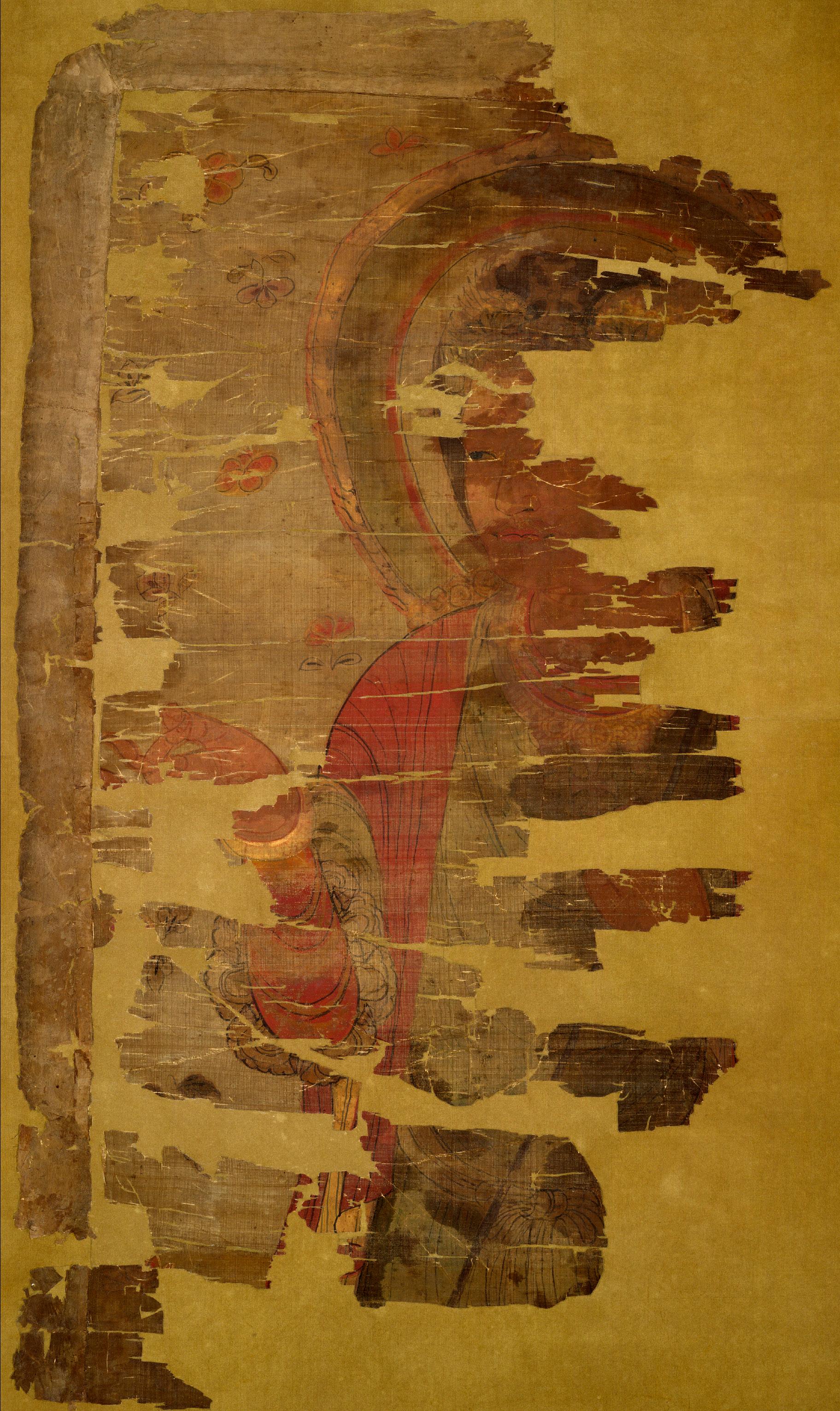
We also see this tactic, of communicating Christianity through the language of philosophies and religions that were already popular in China, in the Jingjiao Stele, composed ca. 781 in Western China. The title translates as “the luminous religion,” which is the name Christianity was known by in the region.4 The Stele, like the Discourse, calls God “the one who is profound reality and spiritual emptiness, the one who is after all and has mysterious existence,” and identifies Jesus as “the illustrious and honorable messiah” who “established, through the pure Spirit of the Trinity, the new religion of no words.” Christianity itself is “[t]he true and everlasting Way,” “wonderful,” and “very difficult to name.” The reader is told that “Its meritorious results are luminously displayed, and we are forced to call it the Luminous Religion,” whose “holy ones” clearly resemble a variety of recognized monastic profiles from Chinese society. This is, in other words, a Christianity that a Chinese Buddhist or Daoist could fully understand and appreciate without having to significantly change their conceptual vocabulary.
Who were these Christians? Orthodox and Catholic heresiology derides them as “Nestorians.” Over the centuries, the members of this community, 4 Translation and notes in Penn et al., Invitation to Syriac Christianity, 727-738.
the Church of the East—which persists as the Assyrian Church of the East and the Chaldaean Catholic Church—have adopted the term for themselves, effectively reappropriating it. But the name exaggerates the importance of Nestorius in their tradition (which was quite marginal), and it also overlooks Nestorius’s own perception that he had been vindicated at the Council of Chalcedon in 451, as recounted in the Bazaar of Heracleides, his only extant work.
37 jacob's well
Mogao Christian painting, thought to be a depiction of Christ (9th century, Dunhuang) Ink and colors on silk British Museum
To dismiss these Christians because of their association with Nestorius would be to miss out on rich aspects of our Christian tradition. I think a better way of understanding the controversy surrounding Nestorius is to see it as part of the rivalry between the theological academies of Alexandria (where figures like Athanasius and Cyril were taught) and Antioch (the training ground of Theodore of Mopsuestia and John Chrysostom). Antioch’s geographic proximity
to the Syriac-speaking East, and to scholarly cities of deep Christian learning like Edessa and Nisibis, meant that Antiochene Christology was dominant in those regions and that language (a late form of Aramaic, one of Jesus’s daily tongues). Hence, Nestorius’s condemnation, which is still treated by Catholic and Orthodox Christians in their sacred histories as a major event, only registered among Christians in Assyria, Mesopotamia, and Iran because it constituted a rejection of their intellectual lineage.
Beginning in the eighth century, shortly after the Discourse was written, the patriarch of the Church of the East lived in what is now central Iraq, and he was at least theoretically the head of Christians as distant as the Western Chinese steppe. For all of the past's Catholic-Orthodox infighting about legitimate succession to the ancient Church, both claims are simply dwarfed by the premodern immensity of the Church of the East, which boasted millions beyond the borders of the Roman Empire at its height.
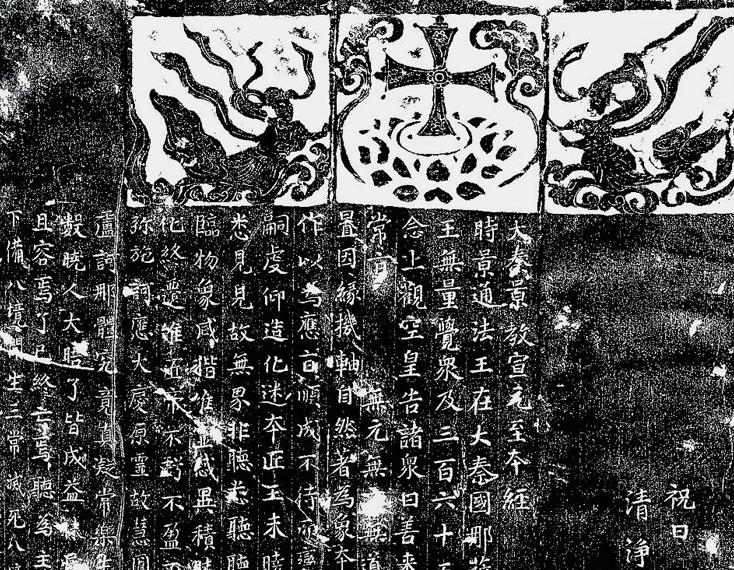
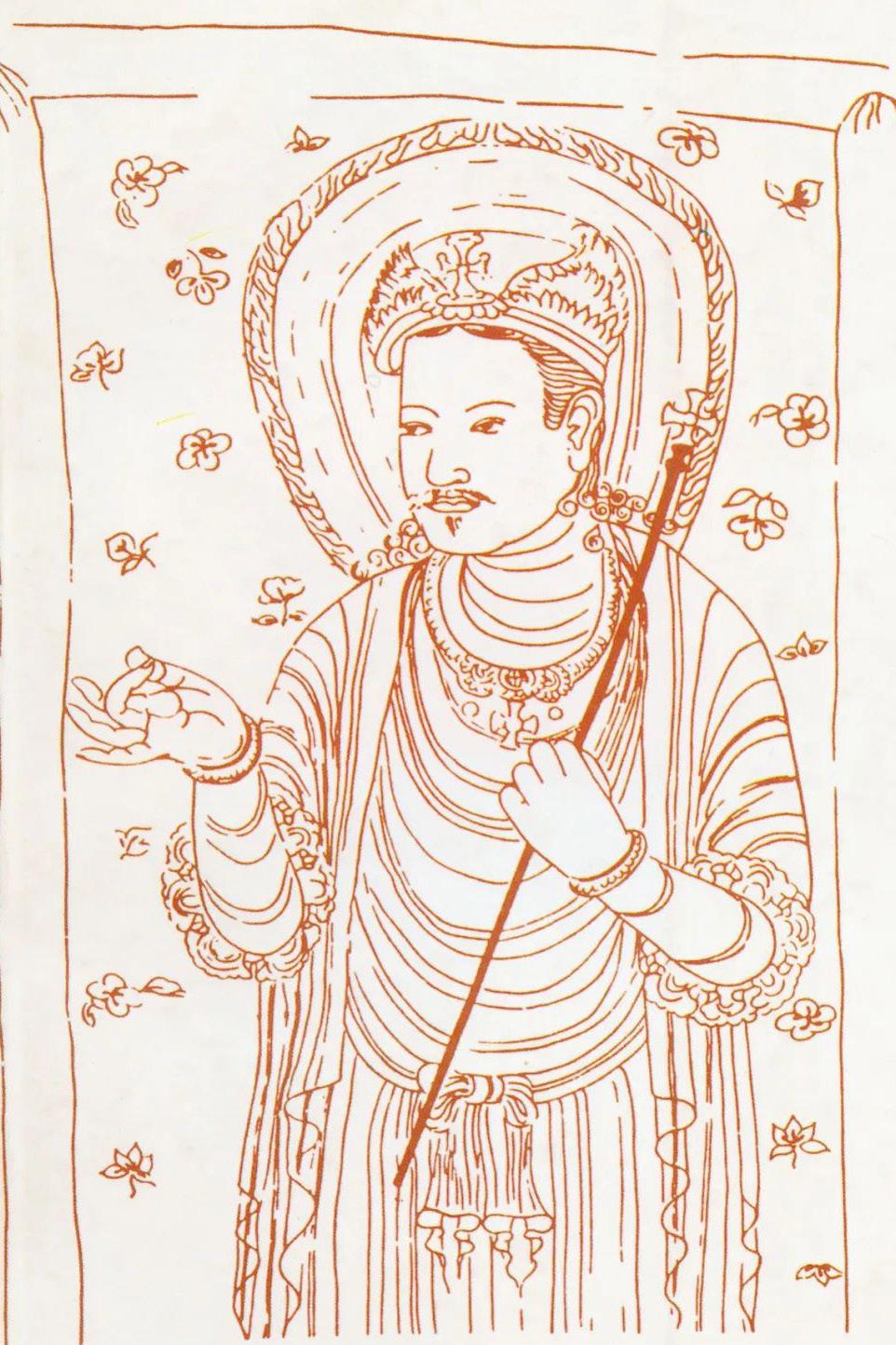
This church and its missionary accomplishment were the stuff of legend for Western Christians for centuries.5 The full extent of the synthesis is lost to us now in the wake of the church’s decline, but the picture that emerges from the sources that do remain is of a Christian tradition thoroughly engaged with other faiths and philosophies indigenous to Asia, one that fit right in among the various cultures that East Syrian Christians sojourned among. When Rabban BarSauma (1220-1290), a Uyghr Christian monk, made his own “Journey to the West” from China to Jerusalem, and then on to Rome as an ambassador of the Church of the East, it was a seismic news story for late medieval Europe. When around the same time Marco Polo (c. 1254-1324) traveled on behalf of the court of Kublai Khan, he met Nestorian Christians in the Khanate’s borders. Significantly, later Christian missionaries from the West, primarily Catholic and Protestant, would be less accommodating to the indigenous cultures of Asia and less appreciative of the humanistic and religious wisdom already present there.
5 A popular and competent introduction is Philip Jenkins, The Lost History of Christianity: The Thousand-Year Golden Age of the Church in the Middle East, Africa, and Asia—and How It Died (San Francisco: HarperOne, 2008); this year, though, look for Francois Briquel Chatonnet and Muriel Debie, The Syriac World: In Search of a Forgotten Christianity, trans. Jeffrey Haines (New Haven: Yale University Press, 2023).
jacob's well 38
Reconstruction of the Mogao Christian painting (9th century, Dunhuang)
Rubbings of a Tang dynasty scriptural pillar, the Nestorian pillar of Luoyang (9th century)
The Christianity that is now rapidly growing in Asia can be described in a similar way. Its cultural and intellectual origins are Western, derived from European Catholicism and American evangelical Protestantism. Yet like the premodern Nestorians, modern Christians in China, India, and Southeast Asia are, together with Christians in the rest of the Global South like Africa and Central and South America, the fastest-growing Christian body in the world. China, for example, is on track to encompass the largest population of Christians in the world by 2030. This raises the question: will Christianity’s future in Asia be that of an Asian religion, or a Western religion in Asia?
This demographic and religious trend is part and parcel of the wider angst for the “Asian century”: that is, the cultural and economic shift of the world’s global center to the Asia-Pacific in light of the cultural ascendance of countries like China, Japan, and India. My concern, though, is that whether or not we have an “Asian century” politically and economically, a Christian “Asian century” seems doomed to be a Western export in Asian lands. It doesn’t have to be this way; the alternative is a genuinely inculturated, indigenous product of synthesis between Christianity and its new-old intellectual environments—in spiritual ecosystems still inhabited by brahmanic deities, bodhisattvas, immortal sages, magic, and folk religion (but also, more recently, by atheistic secularism). My hope for Christian communities in Asia is that their experience will be one more like their premodern forbears than like those of their more modern ancestors: one defined by dialogue, sharing, and, yes, rich syncretism.
I acknowledge that for some Christians, including for many Asian Christians themselves, that hope will raise an alarm. Am I trying to dilute the purity of the Gospel with accommodation of non-Christian religions and philosophies? But we should recall that Mediterranean and Near Eastern Christianity became what it did by the same means, assimilating the intellectual sophistication and conceptual catalog of GrecoRoman philosophy to reimagine the meaning of its originating Jewish apocalyptic movement. Indeed, doing so offered the language that made possible certain ideas that now mark Christianity
as a global faith, like the dogmas of the Trinity, the Incarnation, and the union of divinity and humanity in Jesus Christ.
So why not expect a similar gift of perennial import to come from the Christian dialogue with Daoism, Buddhism, or Hinduism, not to mention Islam and Sikhism? Why not, for example, see the possibility of describing God’s nature as “Emptiness” not just as a local oddity of Asian Christianity.
Certainly, the language of God as “Emptiness” can be jarring for Westerners—among whom, from this global perspective, the “Eastern” Orthodox have to counterintuitively count themselves—but it also might have much to offer us. For example, God as generative “Emptiness” offers a way out of some of the modern debates in theology about the unknowability of God’s essence. This is not even a totally alien idea from the Orthodox tradition itself: one way that Pseudo-Dionysios the Areopagite describes God is as “the all, and no thing” (DN I.6), as “unconfined by form” (IV.3), as the basis for “the interrelationship of all things,” the “intermingling of everything,” and the “unceasing emergence of things” (IV.7).
These are all ideas represented in Buddhist and Daoist traditions precisely by the language of “Emptiness,” which is why the authors of the Discourse and the Stele drew on those terms. The possibilities of an Asian future for Christianity then come from asking ourselves: What else do those traditions and others say that can enrich our experience of Christianity through integration? In that vein, one hopes that the Asian Christianity of the future will instead be the kind that is able to find new syntheses with traditional and modern Asian cultures that are as winsome, critically informed, and imaginative as the God Who, Himself formless, continually generates ever new and marvelous forms of being, mind, and life.
39 jacob's well
DAVID ARMSTRONG is a Classics teacher in St. Louis and writes the Substack newsletter A Perennial Digression
Family Fissures
ON THE CHALLENGES AND JOYS OF BLENDED FAMILIES
by AMELIA ANTZOULATOS
Back in 2012, when Katherine created an account on Orthodox Circle, the social networking platform for Orthodox Christians, she didn’t realize others had already started using it as a way to meet future spouses. “I was just on because I like to connect with other Orthodox,” she said with a laugh.
But she hadn’t been on the platform long before she met Steven; they both felt a spark, and after about five months of talking long-distance— and, eventually, meeting halfway—Katherine decided to visit Steven.* “I think we both kind of knew what we were looking for, so we were just like, why waste time?” she said. Soon they decided Katherine would move to the same vicinity. Steven was the primary caretaker of his three children, and Katherine wanted to “enter gently” into their lives.
Eventually Katherine and Steven were married, forming what’s known as a blended family, or a step-family. A blended family comprises spouses who have children from previous relationships, and it can include at least one step-parent, step-sibling, and/or half-sibling (as it does in Katherine’s case, as she and Steven welcomed a new child into the family several years ago). Step-families are common in the United States; according to a 2013 Pew Research study, 23% of married people had been previously married, and 40% of marriages that year included a spouse who had been married at least once before.
Blended families face joys and challenges that can be heightened by their unique circumstances, which may involve the process of healing from the pain and loss of a previous family dynamic— whether the cause was divorce or the death of a parent/spouse. In the case of Orthodox blended families, faith typically informs the ways they approach some of these challenges.
Katherine had converted to the Orthodox faith in her early twenties. Steven and his ex-wife had also converted to Orthodoxy after getting married, but church had become less than a priority as their marriage became more troubled. Shortly before meeting Katherine, Steven had decided to recommit to the faith, pushing himself and his children to become more involved in parish life. Though his ex-wife had left the Church after the divorce, she supported the children’s faith and helped them during fasting periods. “I felt like, okay, the odds are in our favor that the children are going to remain Orthodox,” Katherine said. (Often it doesn’t go this way—surveys have found that people raised by divorced parents are more likely to be religiously unaffiliated than those whose parents stay together.)
Now, after 10 years together, Katherine says certain unspoken boundaries remain in their household. The children tend to be “emotionally closed off” with her, disinclined to discuss how they feel about the family situation, although she and her middle stepchild have made strides over time. It’s common for children to be wary of stepparents, especially if they’re facing a loyalty conflict and feel they have to side with one parent over the other. Cooperation among adults can ease these kinds of tensions, but that requires buy-in from all parties. “It would be great if we could all be one big, happy family,” Katherine said. “Through many tears, I tried to force it to be that, but I realized I can't— this is beyond my control.” Early in the marriage, her husband’s ex-wife declined her suggestion that they get to know each other.
In general, children in blended families also must deal with their own disappointments. One priest noted that during confession or spiritual advisory sessions, when children of divorce broach the subject of their parents, they often “just start
jacob's well 40
*Katherine and her family’s names and biographical information have been changed to protect their privacy.
crying.” He always reminds them not to blame or judge themselves for the brokenness, or the toxicity, of their family dynamic.
Eva Konstantakos, the director of Youth and Young Adult Ministries for the Greek Orthodox Archdiocese (GOA), has similarly observed that Orthodox summer camps, places where young people tend to feel the safest, are also often sites of disclosure about mental health and other struggles. Her ministry has been in dialogue with the Orthodox Christian Association of Medicine, Psychology, and Religion (OCAMPR) about expanding the availability of mental health training and awareness for youth workers across the GOA. Those conversations are also beginning to take place in the Youth Committee of the Assembly of Canonical Orthodox Bishops.
Despite these challenges, there are also many blessings in blended families. Over time, Katherine began noticing a greater openness among her stepchildren, who had seemed “closed off socially” after the fallout from the divorce. Her natural inclination to be part of the social life of her new congregation, which had warmly
welcomed her, made it easy for her to meet new people, and this in turn pushed the children to become more open. “Several people had come up to me and said how glad they were that I had come into the kids’ lives,” she said, “and that after a few months, some could even tell that the kids had changed in a really good way.”
Along with “a lot of counseling” from her therapist and regular guidance from her spiritual father, Katherine felt that having a supportive husband who was cognizant of her needs was one of the main reasons their marriage survived. (And about 67% of second marriages don’t.) Even so, it took four or five years for everyone to find their role in their dynamic, and for her to reach a point where she could “talk about this calmly, and not cry through the whole thing.” She characterized it as a kind of grieving process: “It’s like going through very much alone.”
Online support groups and exchanges with other stepmoms on Facebook helped her through difficult times—though she wished there were more resources available within the Church. She and her husband often consulted with their
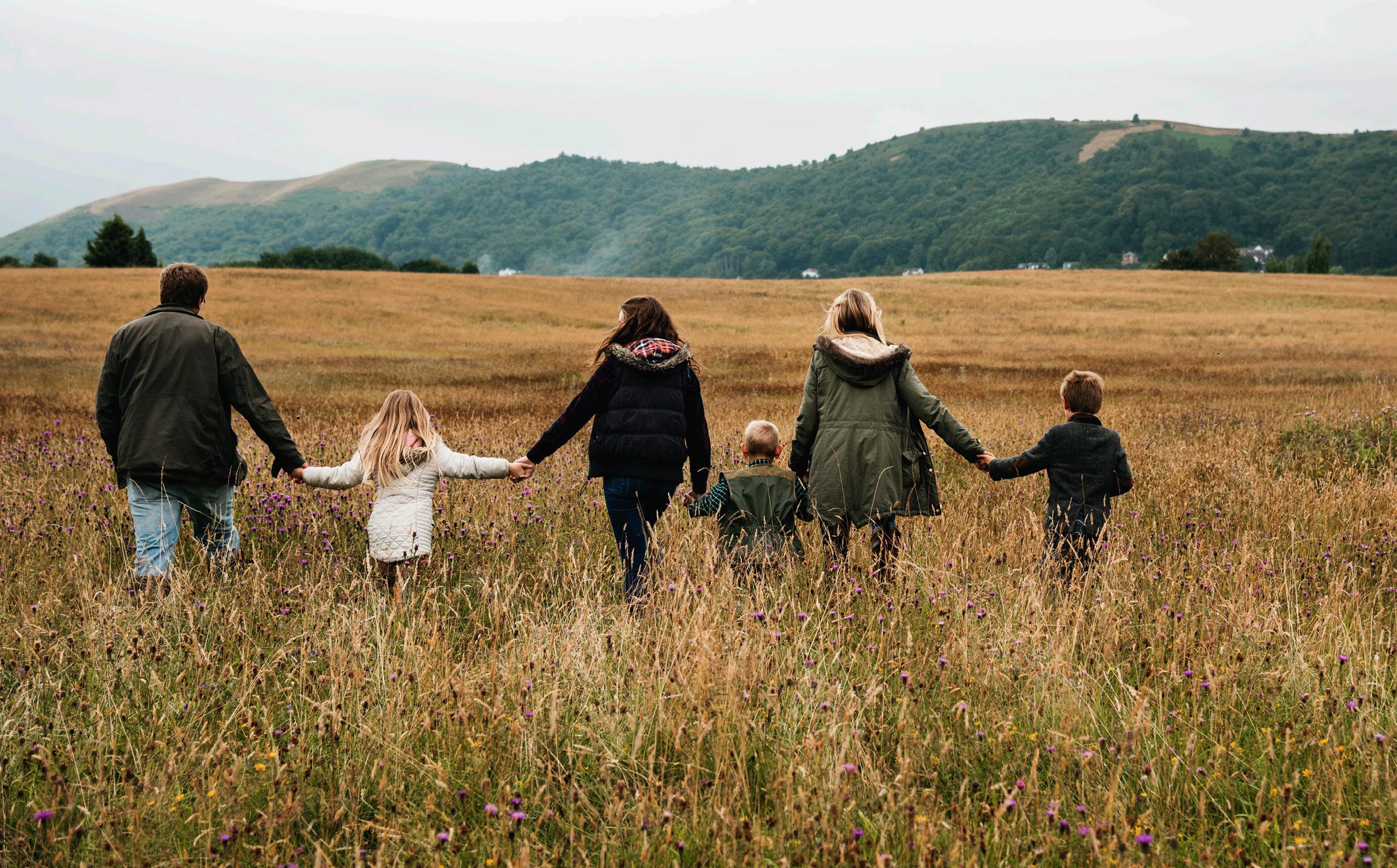
41 jacob's well
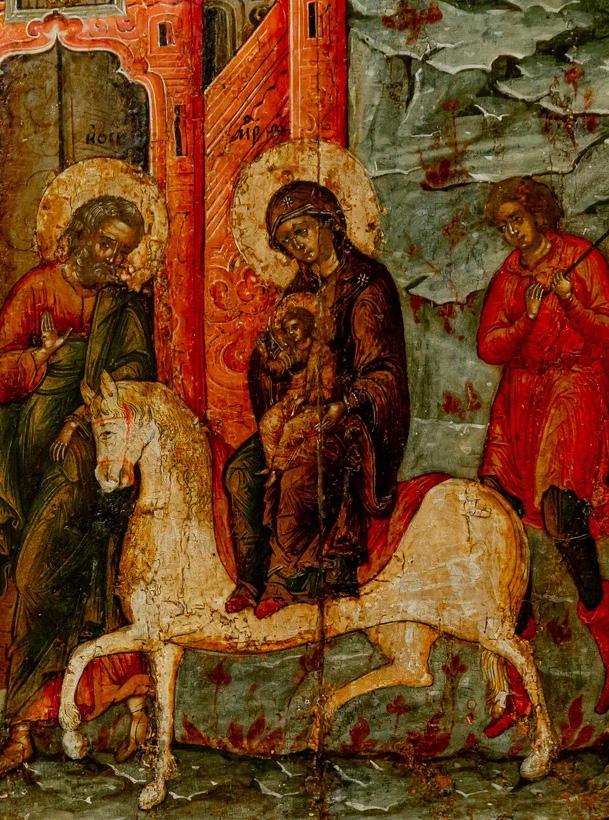
jacob's well 42
Detail of the icon of the Nativity of Christ (Russian, 18th century)
Andrei Rublev Museum
parish priest, but he struggled to offer practical advice. “In terms of the Orthodox support for blended families, it’s not there,” Katherine said. She suggested there be a specific ministry, or at least training for priests on how to deal with these situations, “because it’s very different from regular family counseling.”
V. Rev. Nicholas Solak, chair of the OCA’s Office of Pastoral Life, agreed that seminary curricula are lacking in this area. The GOA Center for Family Care develops digital and in-person programs, customizable retreats, and resources for couples and families, but again, few resources are tailored for blended families and there are no additional guidelines for their pastoral care.
There are wide variations in pastoral family care, too, even within jurisdictions. A 2013 report by the Committee of Pastoral Practice for the Canonical Orthodox Bishops found that while most jurisdictions “required or at least offered” premarital couples counseling, the timeline varied and “generally depended on the practice of the local priest.” Likewise in cases of divorce, for which jurisdictions mostly relied upon the local parish to provide counseling and help to couples. The limitations of institutional support are hardly surprising; as Konstantakos noted, low funding and understaffing are perennial obstacles for church ministries.
What, then, could be useful to blended families? According to Katherine, resources that help with setting realistic expectations are tantamount, because they can transform spouses’ mindsets for the better. Support groups guided by an Orthodox ethos, for example, provide opportunities for connection with others working through the same challenges, but who are also seeking answers in the same Orthodox values. For someone like Katherine, Orthodoxy “informs everything” in her life, but it also makes sense that anyone choosing and navigating an Orthodox marriage will likely need an Orthodox mindset. Now that she’s found greater peace and stability in her own family dynamic, Katherine is considering starting a support group in her area. Life-coaching
for blended family members could also be an option, while others have suggested retreats where step-parents with all levels of experience can share their stories and advice.
Demystifying divorce and blended marriage in the Church is important, Katherine said, so that the shame or guilt that sometimes accompanies it—something she noticed in her eldest stepchild especially—can also be addressed. Resources from the GOA’s young adult ministry aim to
communicate that families of all kinds are rooted in Christ, a foundation that is unifying in its applicability and can be “built upon for the realities of each individual parish,” said Konstantakos.
The youth ministries director does believe, however, that more can be done in her jurisdiction to help blended families at the direct level. She said there’s a general need for parishes to recognize that every member is responsible for sustaining our larger family: “As the saying goes, it takes a village to raise a child, but in our case, it takes a full community of faithful—the full body of Christ— to raise a child in the Church.”
AMELIA ANTZOULATOS is an assistant editor of Jacob’s Well. She works with the Greek Orthodox Archdiocese of America, and her home parish is the Cathedral of Saint John the Theologian in Tenafly, New Jersey.
43 jacob's well
"Demystifying divorce and blended marriage in the Church is important, Katherine said, so that the shame or guilt that sometimes accompanies it...can also be addressed."
by ARCHPRIEST MICHAEL MEERSON
Fr. Alexander Men and Fr. Alexander Schmemann never met. Although they lived and worked under totally different circumstances, the life of each was short by modern standards. Fr. Men was assassinated in 1990, at the age of 55, after a year of receiving letters warning him to either stop his missionary activity or leave Russia if he wished to stay alive. Fr. Schmemann died of cancer in 1983, at the age of 62. Yet the influence of each continues to be felt throughout the Orthodox world today.
I was blessed to know both priests personally and be inspired by them. In the decades since they reposed, as I’ve reflected on my experiences with them and pored over their writings, I’ve realized there was a remarkable overlap in their apostolic work. Each of them in his own way became a living embodiment of the same theme:

“Jesus Christ is the same yesterday, today, and forever.” (Heb. 13:8)
In theological terms, this concluding statement of the Letter to the Hebrews suggests that Jesus remains the same throughout human history—for He has entered it from eternity—and with Him, and in Him, eternity has permeated time. It implies that the church, His Body, is contemporaneous with every historical epoch. Both priests witnessed this belief in what has been called our “post-Christian era,” a time in which historical Christendom seems to be in retreat.
jacob's well 44
Fr. Alexander Men
In Fr. Men's environment, this retreat was more than obvious; it seemed to be total, and the Orthodox Church seemed to be irretrievably locked in the past. The Russian Orthodox empire had been replaced by a militant regime that renounced religion as such, and attempted to erect a new civilization, based on the modernist premises of atheistic humanism and scientism, and upon a totalitarian economic and political doctrine informed by those premises.
Born in Moscow on January 22, 1935, Fr. Men was baptized and raised in a small, underground community of believers who struggled to preserve the traditions of the Russian Orthodox Church, uncontaminated by any collaboration with Communist authorities. As a priest, however, his mission was not to preserve and restore the bygone Orthodox past. Instead, it was to see the Orthodox tradition reveal its true treasure—namely the presence in it of “Jesus Christ, who is the same yesterday, today, and forever.” Against the overwhelming background of Soviet ideological materialism, he evoked the worldwide expansion of human spirituality as found in religions of mankind.
As a theologian, Fr. Men is best known for a multivolume series, History of Religion, that frames the world’s spiritual traditions as a collective search for the Face of God—which, as he shows, is revealed in Christ. In these texts, Fr. Men deals with the nature of religion in general, arguing that it cannot be superseded by anything, because it addresses and expresses the very essence of human nature. He later traces the historical development of religions throughout the world: in the primitive societies of Egypt and Sumer, and in ancient India, China, and Greece. The penultimate volume focuses on the Hebrew prophets, while the final volume describes the historical, cultural, and religious context of the first century, in which the Good News was proclaimed first to the Jews and then, immediately, to the whole Hellenistic and
Roman world at large. The last book in this series, which he began writing as a teenager, was The Son of Man. It became his most famous one.
Fr. Men is also remembered widely for his work as a minister. He earned the trust of thousands of believers in the communist Soviet Union. It wasn’t only because of his brilliant ideas, and their skillful exploration, that his ministry succeeded—nor was it all because of his great erudition and enormous productivity. Most of all, it was because of his pastoral gifts. I have not known another priest who could be so perfectly described by the words of St. Paul: “I have become all things to all men, that I might by all means save some.” (1 Cor. 9:22)
Fr. Vladimir Zelinsky, an Orthodox priest and prolific Christian thinker and writer who, as a religious dissident in the Soviet Union knew Fr. Men closely, superbly summed up Fr. Men’s ministerial gifts in a tribute in 2022.1 The martyred priest had the blessed gift to “take upon himself the cross of a stranger,” Fr. Zelinsky wrote. Fr. Men was able to share deeply in the pain of a parent who had lost a child, in the loneliness of a widow, and in the discomfort of a “well-read yet confused young intellectual.” “There are many pastorteachers who know well how and what to teach,” Fr. Zelinsky went on, “and who know how to do it well, there are few elders who communicate the will of God, but in all, I think, there are even fewer those who are ready to provide their own personality as a breeding ground for the growth in Christ for another person.”
People were drawn to Fr. Men as to a living embodiment of some tangible, yet unknown presence, for which they could find only one name: the divine presence. Each of his spiritual children became his friend, as I can personally testify. I was baptized as a child, but did not receive religious education, having been raised in the Soviet atheist system. I found my way out of atheism through intellectual means of philosophical search, my acquaintances with dissidents, and reading forbidden literature. Yet, it all failed to lead me to the Christian
1 Arch. Vladimir Zelinsky, the rector of the Orthodox Church of Mother of God of the Sign in Bresia, Italy, is the author of many books, written and published in Russian, French, and Italian. Among them are: Zametit’ Khrista v tvorenii (Notice Christ in Creation), Moscow, 2022; Revele moi Ta face, Edition, Parole et Silence, 2006; and Sviashchennoe remeslo (The Sacred Trade), St. Petersburg, Aleteia, 2017. His memoirs of Fr. Men were published last year: “Fr. Alexander Men’s heritage and his three messages,” Christianos, # XXXI, Fr. Men’s Memorial International Charitable Society, Riga, Latvia, 2022, 46-47.
Fr. Men
45 jacob's well
faith and the Orthodox Church. The latter merely repelled with its foreignness, incomprehensibility, and seemingly complete lack of relevance.
Fr. Men changed all of this. At our first meeting, I instantaneously felt his kinship. Through him I was able to enter the church, and feel at home in it, because it was home for him.
Ultimately, Fr. Men and I collaborated closely for almost seven years, first to publish his books underground—as samizdat—and later to promote and reproduce the works of Russian religious thinkers like Nikolay Berdiaev, Fr. Sergey Bulgakov, Fr. George Florovsky, and Fr. Alexander Schmemann, all of whom influenced Fr. Alexander Men and whose work he carried on behind the Iron Curtain.

Fr. Schmemann
After I escaped imprisonment in the Soviet Union for my underground publishing activity, I stayed briefly in France (1972-73), where I worked for a Russian Orthodox emigre press. At the end of 1973, I came to the United States. Fr. Alexander Schmemann, whom I had met in Paris at a conference of Orthodox youth, invited me to stay in his house. He was passionately interested in the religious revival and human rights movement in the Soviet Union and found in me one who represented both trends and was able to witness to it and convey my experience in writing.2 Later, his interest in Russian revival brought him in contact with Alexander Solzhenitsyn, becoming his father-confessor and close friend.
In Fr. Schmemann’s house I had the familiar feeling that the church was his home. After he took me to St. Vladimir’s Seminary, I felt that the seminary and the church he represented— the Orthodox Church in America—could also become my home. During my years of study under Fr. Schmemann, and having him as my fatherconfessor, I realized that despite their different cultural backgrounds, he was endowed with the same spirit as Fr. Men. Both were broadminded, spiritually sober, bold, and independent in pursuing their missions.
Fr. Schmemann lived all his life in the West: first in Paris, where he ultimately became a professor of theology at St. Sergius Institute, and later in New York, where he taught at St. Vladimir’s. He saw his main task as bringing the Orthodox Church to conformance with the contemporaneity of Jesus’ everlasting presence in it, by revealing its relevance to modernity and opening it up for strangers.
Fr. Alexander perceived the Eucharist as a forgotten treasure within the church. He understood his mission as helping others rediscover it and to bring it back to the center of their experience with Orthodox worship. He made it a priority to achieve all-congregational regular communion throughout the whole OCA—which he saw as the only way for Orthodoxy in America to survive and grow. In the old world, he argued, the Orthodox Church had been supported for centuries by national states and/ or ethnic communities with their local traditions. In America, Orthodox Christians lack state support, and no ethnic cultural tradition, he argued—be it Russian, Romanian, Albanian, or Greek—would be enough to bind church communities together for generations to come. What would hold it together and attract to it others, then? Solely Jesus Christ, “Who is the same yesterday, today, and forever.”
2 One of the early outcomes of this experience was the book which I co-authored with my friend and fellow dissident Boris Shragin: The Political, Social and Religious Thought of Russian ‘Samizdat’ - An Anthology, Belmond, Mass: Nordland Publishing Co. 1977. I prepared this book for publication in my spare time during study at St. Vladimir's and was lucky to find there the publisher for it—Richard Haugh, the son-in-law of the seminary's professor and provost, Sergey Verkhovskoy.
jacob's well 46
Illustration: Sophie Ries
A message radiates from Fr. Schmemann’s books, articles, sermons, and lectures: Christ is present in the Eucharist, and this presence is so powerful and vital that it makes the church ever young and fruitful. We Orthodox Christians do not have to feel buried beneath the layers of our ancient, venerable tradition or our ethnic customs. With the Eucharist set at the heart of church life, everything finds itself in the proper place and perspective. We don’t need to run after today’s fads, struggling to conform to a continually changing modernity. Christ always addresses “what is timeless and changeless in man himself.”3
Along with regular communion, Fr. Alexander sought to revive another liturgical tradition: the loud and clear recitation of the so-called “secret prayers” of the Anaphora. The name comes from the association of these prayers with the sacraments; but over time, it had become customary for priests to mumble the prayers to themselves behind the closed royal doors, effectively keeping them secret from the congregation. There was an idea that if they were spoken loudly, it might “desecrate them.” In fact, the entire content of the Liturgy as the believer’s preparation for the acceptance of God, in the form of the sacrament, is expressed in these prayers.
Fr. Alexander began training seminarians to say the Anaphora’s prayers audibly, on behalf of all the faithful. He managed to educate several generations of ministers in this practice—although, sadly, since his death, this tradition has again fallen away, and to some extent the Orthodox Liturgy has returned to its usual clerical routine.
In his book Great Lent, Fr. Alexander shows how in our worship we relive the sacred history of salvation. Through the liturgical celebrations of Great Lent, we reenact the biblical stories of Adam’s creation and fall, of the exile from paradise, and of the Hebrews’ wandering through their exodus from slavery. It is the living liturgical participation in the events that saves us from regarding them as mere ancient tales with no application to our own lives. We celebrate Adam’s expulsion from Paradise not as some pre-historical episode, but as a universal event of personal relevance to each of us. I, myself, am Adam (man), who am expelled for my own unfaithfulness; I am sitting “by the rivers of Babylon”
and weeping (Comp.137 (136) Psalm). At the Matins of Holy Saturday, the reading of Ezekiel’s prophecy about the dry bones of the House of Israel (37:1-14) proclaims the general resurrection. Listening to this prophecy, in front of Jesus’ burial shroud, I, myself am thrilled with the anticipation of my own dead and dry bones which the power of God’s Spirit can restore to wholeness and revive.
Yet I lacked this vision and awareness before my study in his seminary. It was these years with Fr. Alexander that transformed the tedious and ill-understood Orthodox Liturgy into something meaningful, relevant, and indispensable.
Summing up my brief recollections about Fr. Men and Fr. Schmemann, I trust that I grew up as a Christian under two great missionaries of Orthodoxy, one for Soviet society, the other for the Orthodox Church in the free world. I see the strength and success of their apostolate in their creative ability and fearlessness to discover in the Orthodox tradition the possibilities of renewal and growth hidden in it. Cutting through secondary things and centuries of outdated customs, they found and pointed to the direct access to Christ—who again and again, for every generation, opens in His church the sources of living water, being the same “yesterday, today and forever.” They left us the legacy of this belief in their life work, personal example, and writings. I pray that simply addressing their memory may revive in us the same feeling of eternal, living, and tangible presence of Christ in the Church traditions to which they stayed faithful to the end. Despite their many tribulations, their suffering, and their untimely deaths, they both were of “good cheer,” and, as it turned out, they won— because it was the One, whom they trusted and who acted through them, that said: “In the world you will have tribulation, but be of good cheer, I have overcome the world.” (Jn.16:33)
3 A. Schmemann, Journal, “Dnevniki 1973-1983, Moscow: Russky Put’” 2005, p. 145 (translation is mine, MM)
47 jacob's well
V. REV. MICHAEL MEERSON is the author of several books in English and Russian, including The Trinity of Love in Modern Russian Theology. He is the rector of Christ the Savior church in New York City.
MUSIC IN THE MISSION OF THE ORTHODOX CHURCH
by PRESBYTER MIKEL HILL
It was a remarkable procession that filed through a crowded Episcopal church in Portsmouth, New Hampshire, on September 5, 1905. Leading the procession were the parish’s cross-bearer, acolytes, choir, and rector, Father Charles Brine. Following them were seven Russian Orthodox clerics in richly embroidered vestments, including several who were prominent in the Church’s leadership at the time: Fr. Alexander Hotovitzky, dean of Saint Nicholas Cathedral in New York, Fr. Benedict Turkevich, and Constantine Buketoff, who would later serve as an archpriest in Brooklyn. The occasion that brought these Americans and Russians together was no less remarkable. A treaty, ending the two-year war between Russia and Japan over rival imperial ambitions, had been signed at Portsmouth earlier

that day. In thanksgiving for this event, a service was held to which the Russian, Japanese, and American diplomats had been invited.
Reports describe an extraordinary experience. The service began with evensong, the Anglican choir singing the processional and Magnificat. At its conclusion, Fr. Hotovitzky offered a short homily in English. The Russian clerics then gathered at the high altar and sang the Te Deum (To God) in an arrangement by Dimitri Bortniansky. The New York Tribune described this moment as “the most solemn and impressive of the service.” Hotovitzky likewise reflected in the Russian Orthodox American Messenger, “Such singing, perhaps never heard in this church and in such strong, affecting accord, must have amazed the Americans.” Indeed, wherever the Russian
jacob's well 48
Interior of Christ Church, Portsmouth, NH
1906 Postcard Caption (not pictured) reads: "Interior of Christ Church, where the Russian Envoys attended services."
church was discussed in the American press, the magnificence of her services and the beauty of her music did not fail to amaze.
The Orthodox Church, upon her expansion in the lower forty-eight in the 1880s, gave a prime role to music within her mission to attract nonOrthodox believers. Directors and their choirs acted as ambassadors, presenting the Orthodox Church to American audiences in a wide variety of forms and venues. Confident in their own tradition, they did not shy away from appearing in contexts outside their own church, viewing such encounters as opportunities. Parish priests also recognized the power of music to act as a bridge between Russian Orthodox and Americans. In 1919, Fr. Joseph Stephanko, the rector of Ss. Peter and Paul in Passaic, New Jersey, arranged for his parish’s choir to present a concert. At this event, Fr. Joseph explained that its purpose was “to show the soul of the Russian people as it expresses itself in its devotion, knowing full well that its splendor will not only appeal to the American people, but that it will also reveal the beauty and solemnity of Russian church music.”

The best way to understand the place of music within the mission of the Orthodox Church during the early twentieth century is to examine the careers of two church musicians: John G. Boruch, the director of the parish choir in Passaic, and Constantine Buketoff, a priest and noted baritone soloist. The records of their activities
illustrate a common approach by which Orthodox immigrants engaged with the wider ecclesial culture of the United States.
John G. Boruch served as choir director in Passaic, New Jersey from 1903 to 1932. Under his direction, the choir of Ss. Peter and Paul became one of the largest and most renowned choral ensembles in New Jersey. Boruch was born in 1877 in Galicia, (in modern-day Western Ukraine). After emigrating to the United States in 1897, he first served as choir director in Olyphant, Pennsylvania and later in Passaic, where he and his wife, Mary Maceiko, raised two sons and two daughters. In 1932, Boruch was ordained to the holy priesthood and moved to North Carolina to serve a parish near Wilmington, remaining there until his death in 1969.
Throughout Boruch’s tenure in Passaic, newspaper reports provide a glimpse of the broad range of his activities. In 1905, he and his choir appeared on a program at Passaic’s Reid Memorial Library. The Passaic Daily News commented that the choir sang selections in both English and Russian “in a most capable manner.” The evening concluded with a rousing rendition of “America the Beautiful.” And in 1913, a new church for Ss. Peter and Paul was consecrated in an impressive service. In the spacious choir loft, Boruch’s
49 jacob's well
Choir of Ss. Peter and Paul, 1919
singers were joined by Igor Gorokhov and the celebrated male choir of New York’s St. Nicholas Cathedral on 97th Street. The impact of the music on the non-Orthodox guests at these events was obvious. After the consecration service, the Daily News observed, “Russian music will surely have a place in the memories of those strangers who attended the dedication services yesterday and it might be said that there was a great number of outside denominations represented.”
Among those denominations most impressed by the Orthodox Church and its musical tradition was the Episcopal Church. At the national General Convention of the Episcopal Church held in New York in 1913, the choir of the Russian cathedral gave a concert that was much discussed afterward. The following year, Passaic’s Episcopal Church of St. John invited Boruch and his choir to take part in a “special musical service.” The service was introduced by the St. John’s boys choir singing Choral Evensong in a setting by Thomas Tallis. Boruch’s mixed choir of 60 voices, in turn, offered several selections that included “The Opening Psalm”—in Russian—by IppolitoffIvanoff and J.B. Dyke’s “Lead Kindly Light,” sung in English. Such was the success of the concert that the invitation was repeated the following year. Such examples show that music was an ideal vehicle for the Orthodox community to present the spirit of its faith in a congenial and non-
combative manner. John Boruch, as a capable director, served to directly represent the beauty of Orthodox worship to the larger Christian world in liturgical contexts.
If John Boruch represented the Orthodox faith through his facility as a choir director, others during the early twentieth century brought wide recognition to the Orthodox Church by their accomplishments as soloists. A leading example is Constantine Buketoff.
Buketoff was born in Kherson (in modernday Ukraine) in 1881. As a child, he was a soloist at the Kherson Cathedral. In 1904, he moved to the United States, where his older brother, Feophan, was the priest at Three Saints in Ansonia, Connecticut, near New Haven. Constantine directed the choir at Three Saints for two years, during which time he sang at the momentous Portsmouth event. He briefly returned to his homeland in 1907 to marry the 16-year old Millitza Lebedeff, the daughter of a priest. Upon his return, Constantine was ordained to the priesthood by Bishop Raphael (Hawaweeny). He served as rector in New Britain and Hartford and helped to establish several other parishes in the Connecticut area. In 1919, Bolshevik agitation at his parish in Hartford forced Fr. Constantine and

jacob's well 50
Fr. Constantine Buketoff
his family to relocate to New York City, where he became the choir director at the previously mentioned Russian Cathedral of Saint Nicholas.
Before his move to New York, there were occasional news reports of Buketoff performing as a soloist, including a mention of a “musicale” in which he appeared at Hartford’s Asylum Avenue Baptist Church. But it was in New York where his career as a soloist began in earnest, facilitated by his study with the renowned vocal teacher Lazar Samoiloff.
In the April 1920 issue of the Musical Courier, a review introduced Buketoff as the “possessor of an exceptional baritone voice, which has aroused the interest of many persons.” Walter Kramer, editor for Musical America, claimed in the same article that Buketoff “has quite the most phenomenal baritone voice outside of Titta Ruffo.”
Mr. Ruffo himself, the famed Italian baritone of the Metropolitan Opera, reportedly wrote to Mr. Samoiloff to compliment his excellent work as a teacher, adding that Buketoff’s voice “is a most wonderful baritone of gorgeous quality and unlimited range. I am sure under your guidance he will make a most brilliant career.” Buketoff’s range is demonstrated by the repeated instances in which he is praised for his rendition of the Prologue from Leoncavallo’s Pagliacci, which includes both a low B and a high A-flat. After hearing Buketoff’s performance at The Bohemian Club, the famed conductor and accompanist Max Liebling wrote that he had never heard the Prologue sung better.
Fr. Buketoff appeared in dozens of concerts over the course of the next few years. At a performance in New York’s Town Hall, he was joined by both his own choir of St. Nicholas Cathedral and the choir from the Russian Orthodox seminary in Tenafly, New Jersey, under the direction of Dimitri Ressetar. The New York Tribune praised both choirs but said the “best singing was done from the cathedral.” At the concert, Buketoff also sang, as a solo, Mikhail Chernoff’s “The Eagle,” and was praised for possessing a “voice of great beauty and power.”
Buketoff taught Russian music briefly at the Master’s Institute, founded in 1921 by the Russian artist Nicholas Roerich on Riverside Drive in New York. He is listed among its faculty in 1923. He also continued to appear as a soloist, though his pastoral duties occupied most of his attention. He
served for a time at St. Mary’s in Brooklyn, at Ss. Peter & Paul in Bayonne, New Jersey, and finally at Holy Transfiguration Cathedral in Brooklyn, where he stayed for the remaining time of his ministry. His last major musical appearance was at a gala held at the Metropolitan Opera in 1926, at which he was a soloist in Hammerstein and Gershwin’s Song of the Flame.
To encounter an Orthodox priest on the stage of the Met or a Russian choir singing at an Anglican evensong may appear extraordinary in our modern experience. Very few of the vocal ensembles currently championing Russia’s sacred music have any association with the Orthodox Church. Even fewer are soloists whose musical careers are supported by the Orthodox Church. However, the figures of John Boruch and Fr. Constantine Buketoff, both of whom enjoyed wide recognition and popularity both inside and outside the Orthodox Church, were not unique in the ecclesial landscape of the early twentieth century; dozens of other examples can be found. The Orthodox Church viewed these musical ambassadors as essential to her mission to America’s non-Orthodox. Fr. Leonid Turkevich, then dean of Saint Nicholas Cathedral, wrote in 1916: “The love of Russian church music, the growth of which we see of late in America and in England, makes all the Orthodox so truly glad. In this appreciation and the desire to learn more of our divine services we see a measure of kinship, even of the unity, of Christian souls in which the One Christ should reign supreme.”
Metropolitan Leonty’s enthusiasm for the evangelical power of music might serve as a source of inspiration for a revitalization of the mission of the Orthodox Church in the twenty-first century. The Church needs a new generation of musical ambassadors to awaken a sense of kinship among all Christians in America by means of music and thereby to call them to return to the one Christ.
REV. MIKEL HILL is a priest of the Orthodox Church in America. He is the managing editor of St. Tikhon's Monastery Press and a faculty member of the monastery's music institute, where he teaches music history.
51 jacob's well
by SAMIRA KAWASH
p.m. on a Saturday. I’ve been driving for the past two and a half hours. I’m stopped at the intersection, waiting to turn onto my Brooklyn street. I'm hungry and have a carload of laundry and leftovers to unload. There are no garages or driveways in this neighborhood; townhouses are stacked tightly in horizontal rows and cars line the curb up and down the block. I feel the anxiety mounting, the tension in my shoulders. I do what I always do when I make this left-hand turn toward home. I pray for parking: God, please let there be an empty space. Please, God, let it be right in front of my house.
Not surprisingly, this prayer has a poor success rate. God Almighty could certainly give me a parking space if He wanted to. I begin to speculate as to the cause of my failure: That I am not deserving, or pious, or righteous enough to have my petitions granted. That I need to hand over larger bills to the local sidewalk hustlers if I expect something good from God in return. That God is teaching me “a lesson” (patience? fortitude?) by withholding the prized parking space. That God wants me to stop owning a car and is punishing me by making me spend 45 minutes prowling side streets. That God is busy with more important things.
It doesn’t seem so wrong as a prayer. After all, isn’t “give me a parking space” just a variation on Jesus’s instruction that we should pray to God to give us our “daily bread?” It kind of works, if “daily
bread” means “whatever I need at the moment.” But when I think about this parking problem, I begin to suspect that isn’t what Jesus was getting at.
Prayer for Parking 4
When I “pray,” or perhaps more accurately, wish for a parking space in God’s name, what am I really up to? I say I am asking, but when I listen to my voice, it sounds more like a demand. God, give me this parking space that I really want. After all, You love me, and if You love me, You want me to be happy, and if You want me to be happy, then You should give me this parking space. Right now. Because I am getting annoyed at all these other cars that are in my way. This voice is a familiar one; it's the voice of my daughter when she was five, tugging on my hand and pointing to the Lego SpongeBob Krabby Patty Shack kit—pleeeeeeease!! That is me to God, pleeeeease gimme a parking spot, pretty please. I will blame my cranky-toddler attitude on my growling stomach, goading me to treat God like mom with a magic wallet, or like Santa Claus, or maybe worse, like some kind of cosmic vending machine: push the “prayer” button and some goodie falls down the chute, as if God isn’t savvy enough to notice my feeble attempt at manipulation.
Perhaps I can justify my prayer this way: my daughter didn’t need the Legos. But I need a parking space. As in, I will not be able to stop driving until I find a place to put my car. And this could lead to all sorts of evil: I will circle my block in an every widening gyre, muttering curses and
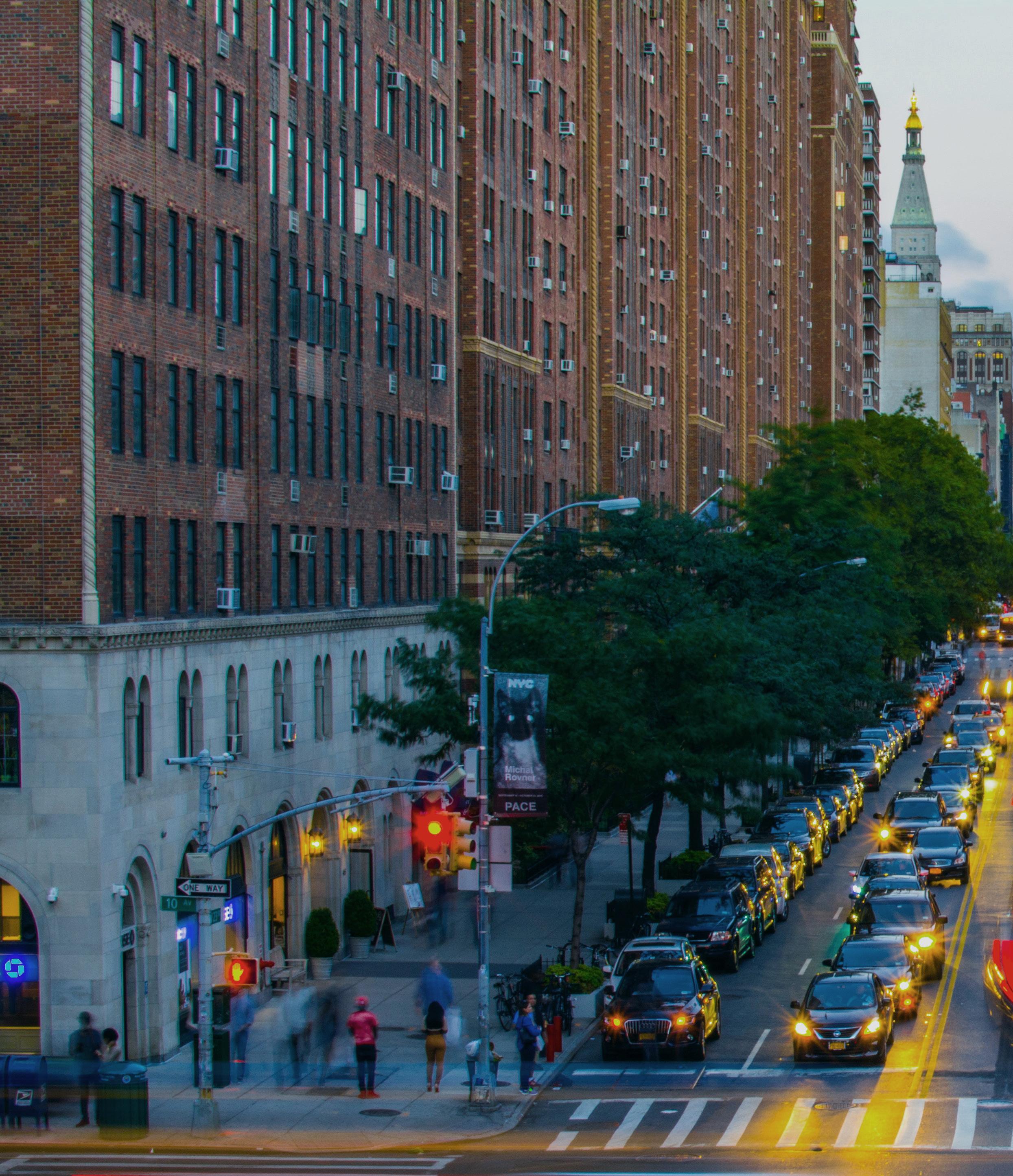
jacob's well 52
polluting the air, until my car runs out of gas or I faint from exhaustion, at which point a tow-truck and/or ambulance will have to be called, the street will be closed down, traffic will grid-lock, critical transportation will cease, and widespread urban catastrophe will ensue. In the urgency of my need, it is not just my fate, but the fate of the entire city that hangs on my gaining this elusive prize. Yes, from my perspective, the drama in my life at this exact moment is the most important thing in the world. God should want to intervene, to save me and save us all.
I remind myself it’s just a parking spot, not something truly life-altering like the Civil War or a nuclear launch or, gasp, college admissions. Nevertheless, I am embarrassed to notice the tone of imperious demand in this prayer for a parking spot. This God seems to be mine alone, the one I expect to serve me here at the center of my little universe. Easy to forget that street parking is a zero-sum enterprise: a place for my Volvo wagon comes at the expense of the silver Toyota circling the block behind me. So, my prayer is not just for the blessings of a generous creation. In the case of parking, there is not enough. God, give me the thing I need, even though it means the silver Toyota will go wanting. God, play favorites. God, choose me.
It is so tempting to use prayer this way, as a weapon in the Hobbesian struggle to wrest my little morsel from the hard matter of existence. My daughter’s pleeeeeeease is just the entry-level
version of the same strategy. I am constantly faced with the problem of not enough—especially living in a crowded city, where there are so many cars, so many bodies, so much desire and demand. I think what I need is a parking spot. But most days, I don’t get it. What I get instead is frustration, cursing, hating my neighbors who took up all the spots, impatience, erratic driving, more cursing.
I finally realize the truth: I’m praying for the wrong thing. And the words come. Thy Kingdom come, Thy will be done, on earth as it is in Heaven. Not somewhere else, in some distant hopedfor future, but now, here. It's hard to find God’s Kingdom on a gritty Brooklyn street, in a parking space that may or may not be waiting for me. But it is here, a glimpse of what is possible. Prayer is the way. God, give me peace. Give me the ability to accept whatever comes with a calm heart. I hope there will be a space for me, but if there is not, God, give me the patience to endure. This prayer, God answers. My breath slows. I pause to let a pedestrian cross. Perhaps my journey will come to its end soon; perhaps it will be a little longer. But right now, in the peace of putting this moment in God’s hands, I feel the gentle touch of paradise.

53 jacob's well
SAMIRA KAWASH is an assistant editor of Jacob’s Well and a professor emerita at Rutgers University. She is a parishioner at the Cathedral of the Holy Virgin Protection in New York City.
The order of the deaconess is a part of the history of the Orthodox Church. In antiquity, she ministered to women much as the male deacon ministered to men. This included providing pastoral care to women, assisting with the baptism of women, visiting and taking communion to the sick, catechesis, supervision at Liturgy, church administration, acting as an agent from/to the bishop, and more, depending on need and location. Throughout the modern period, there have been numerous calls from hierarchs, international consultations, study groups, and others in the Orthodox Church for the revival of this ministry. In 2013, a group of faithful Orthodox Christians formed St. Phoebe Center in response to these calls.
The mission of the St. Phoebe Center is: to educate and prayerfully advocate for the revival of the ordained female diaconate to help serve the ministerial needs of the Orthodox Church and the world today. In the last decade the Center has lifted up the history of deaconesses, shining light on the presence and function of deaconesses in the first millennium of the Church. The Center has also elucidated the real need for the revival of this ordained order—to help overworked priests, to offer woman-to-woman ministry for many issues, and to generally build up the Body of Christ for men and women. In its second decade, the St. Phoebe Center intends to build on this foundation and turn its attention to how the Orthodox Church might welcome women as deaconesses.

jacob's well 54
St. Phoebe Center 10th Year Anniversary Symposium Deaconess for the Orthodox Church Today November 10-12, 2023 Holy Cross Hellenic College Boston, MA orthodoxdeaconess.org
by Scott Cairns

When the God inclined to coat himself in clay, this many-colored coat of clay we wear, the clay itself became the holy craft by which we venture farther into his most holy personhood and very light comprised of holy personhood he deigned to share. Take heart. If his inclination appears just now to have become a waste of good intentions, we might just yet effect a likely course correction, steering north, or east—in any case, some yet untried direction yielding now a somewhat more effectual result.
As most are drawn
to beauty, as all desire joy, we might remember each of these is laden with a measure of descent, that each of these is sore comprised of suffering. Every word proves every bit mysterious as the Word himself, and every term proves crux—
both terminus and new departure. Yea, our comings and our goings yet appear
to occupy a scene of duly tendered travel. Your coracle awaits. Embark.
CORACLE
SCOTT CAIRNS is the author of eight books of poetry, including Philokalia (2002) and Anaphora (2019). He has received fellowships from the Guggenheim Foundation and the National Endowment for the Humanities
Along the Maine Coast (c. 1885)
Alfred Thompson Bricher Los Angeles County Museum of Art
SUDDEN STORMS
 by Sherry Shenoda
by Sherry Shenoda
We small birds in sudden storms preen, persist, outlast out of sight, beaks raking through feathers to oil-armor against this storm and the next, and the next, so when the rain stops, with a shake and a song, we small birds fly.
jacob's well 56
Sherry Shenoda
WATERMELON SEEDS by




According to Coptic oral tradition when the Theotokos, the Mother with the Christ Child received water at the hand of a watermelon farmer embedding smooth black seeds into freshly furrowed fields she paused to bless him and his crop.
The next morning pursuers intending to kill the Child questioned the farmer but turned back, foiled, for Yes, Mother and Child passed this way he said, while I was yet planting seeds. He swept his arm out over the field ripe with heavy-bellied dark green watermelons ready for harvest.
SHERRY SHENODA is a Coptic poet and doctor living near Los Angeles. Working at the intersection of human rights and child health, she serves as a pediatrician in a nonprofit health center. She is the author of the novel The Lightkeeper and the poetry collection Mummy Eaters, which was longlisted for a National Book Award in 2022.
57 jacob's well
2023 Diocesan Graduates High School
Alexander Asinovsky, parishioner at SS. Peter and Paul Church in Bayonne, NJ, graduated from Brooklyn Tech High School. He will attend Bergen Community College, majoring in Engineering.


Aidan Brad, parishioner at Church of the Holy Cross in Medford, NJ, graduated from Williamstown High School. He will attend Rowan University, majoring in Biology/Pre-Med. Aidan was a member of the National Honor Society, German National Honor Society, and The Kitty Hawk Air Society (Honor Society-Air Force JROTC). He was also a four-year Varsity starter on the Cross Country, Indoor Track, and Outdoor Track teams, and will continue to run for Rowan University.
Sophia Bakaletz, parishioner at SS. Peter and Paul Church in Manville, NJ, graduated from Hillsborough High School. She will attend Penn State University, majoring in Business Administration. Sophia was a long standing member of Hillsborough High School’s Student Diversity Club.
Julianna Cheplick, parishioner at Holy Trinity Church in Elmira Heights, NY, graduated from Thomas Edison High School. She will attend SUNY Delhi,
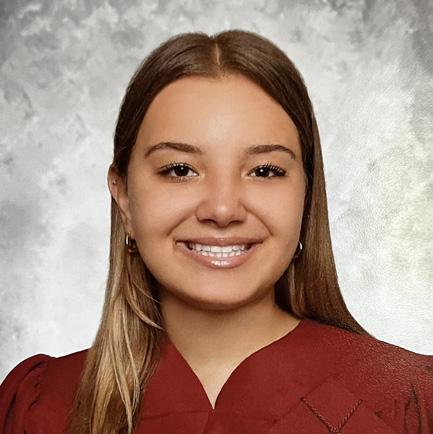
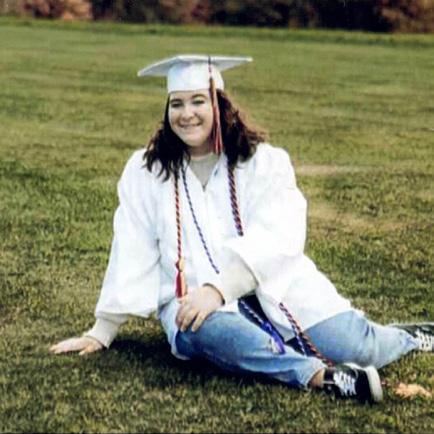

jacob's well 58
majoring in Veterinary Technology. Julianna was inducted into the National Technical Honor Society in 2023 with a 90-percentplus average, and belonged to the Junior Rotarians and Key Club. She studied Animal Sciences in high school and is a Certified Veterinary Assistant.
Nicholas Christos, parishioner at Church of the Annunciation in Brick, NJ, graduated from Toms River High School North. He will attend Lehigh University, majoring in Biomedical Engineering. Nicholas was a member of both the Varsity Chess Team and Varsity Golf, and served as the Golf Team Captain his junior and senior years. He was also a member of the Politics Club, TEAM Club (earning 20+ hours of community service), and coordinated his parish’s Lenten Food Drives.
Anna Davis, parishioner at Holy Trinity Church in Elmira Heights, NY, graduated from Athens Area High School with near perfect attendance and from Northern Tier Technical School’s Culinary Program in Towanda, PA, where she was awarded “Top Senior.” Anna now works as head chef at the Country Club in Towanda, NY.
Mark DaGrosa, parishioner at Church of the Mother of God in Mays Landing, NJ, graduated from Atlantic County Institute of Technology. He will attend Atlantic Cape Community College, majoring in Game Design and Development, having received two scholarships. In addition to being a student speaker at the Thought Leader Forum and playing four years of Varsity Bowling, Mark was a member of the National Honor Society, worked as a lifeguard, published a poem and wrote a song.
Karolina Ellis, parishioner at Cathedral of the Holy Transfiguration of Our Lord in Brooklyn, NY, graduated from Curtis High School in Staten Island, NY. She will attend Syracuse University’s Newhouse School of Public Communications.
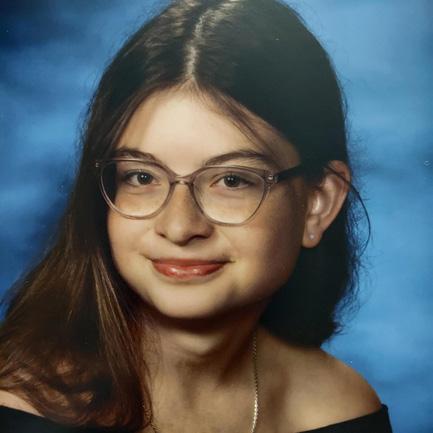

Joseph Ghviniashvili, parishioner at SS. Peter and Paul Church in Manville, NJ, graduated from Bridgewater-Raritan Regional High School. He will attend Raritan Valley Community College, majoring in Software Engineering.
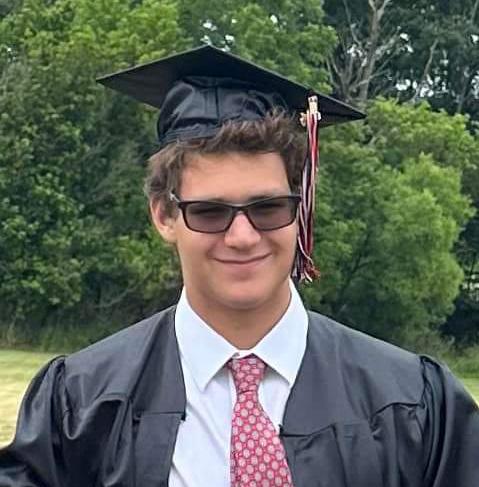
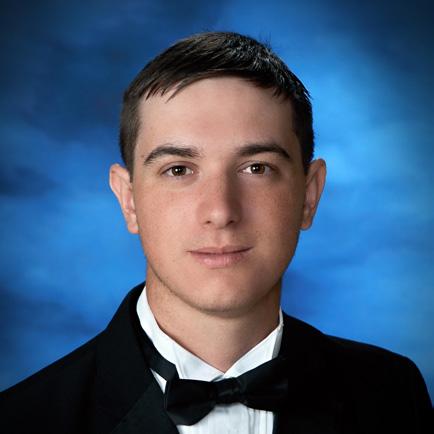

59 jacob's well
Kathryn Illenye, parishioner at SS. Peter and Paul Church in South River, NJ, graduated from East Brunswick High School. She will attend Rutgers University (New Brunswick), majoring in Biology. Kathryn was one of six students in her graduating class to earn an Associate Degree before finishing high school, which she obtained from Middlesex County College in Edison, NJ.
Alexa Ostrowski, parishioner at Holy Resurrection Church in Wayne, NJ, graduated from Hendrick Hudson High School. She will attend the University of Rhode Island and plans to pursue a career in the sciences. Alexa was a member of the Track and Field Team, where she excelled as a shot putter, and the Field Hockey Team, and sang in the chorus.
Saba Kaliashvili, parishioner at SS. Peter and Paul Church in Manville, NJ, graduated from Bridgewater-Raritan Regional High School with a 3.89 GPA. He will attend Rutgers University, majoring in Mechanical Engineering. Saba was a member of the Soccer Team and earned the Somerset County Champion's Title.


Anna Claire Macko, parishioner at Christ the Savior Church in Ballston Lake, NY, graduated from Niskayuna High School. She will attend SUNY New Paltz, majoring in English and Psychology.
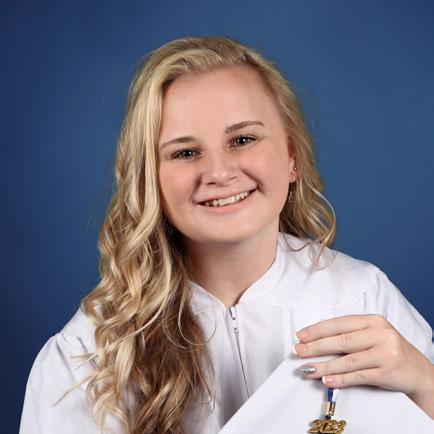
Luke Pylypciw, parishioner at SS. Peter and Paul Church in Endicott, NY, graduated Summa Cum Laude from Union-Endicott High School. He will attend Florida Institute of Technology, majoring in Aviation Management with a concentration in Professional Flight. Luke was an active member in the National Honor Society, NYS Business and Marketing Honor Society, Veterans Club, Key Club, and Technology Club. He was also a four year Scholar Athlete on both the Golf and Basketball Teams.

jacob's well 60
Michael Sadej, parishioner at Cathedral of the Holy Transfiguration of Our Lord in Brooklyn, NY, graduated from Brooklyn Technical High School. He will attend Binghamton University, majoring in Biochemistry.

time. Outside of school, Anna balanced her academic course load while working both at a bakery and chiropractic office.
Alexander Siecienski, parishioner at Church of the Holy Cross in Medford, NJ, graduated from Haddonfield Memorial High School. He will attend Stockton University, majoring in Computer Science. Alex recently achieved the rank of Eagle Scout, the highest award in Scouts BSA.

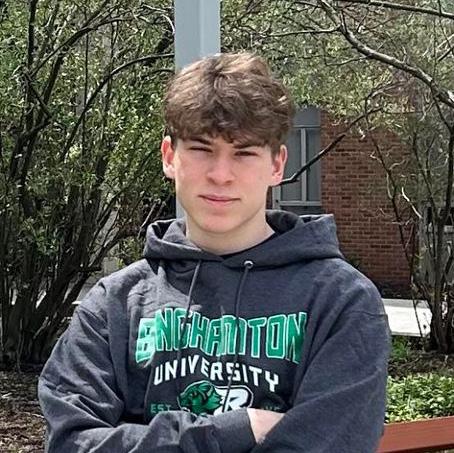
Andrew Steffaro, parishioner at SS. Peter and Paul Church in South River, NJ, graduated from South River High School. He will attend Moravian University, majoring in Business Management. Andrew was a member of the National Honor Society and Captain of the Varsity Football and Baseball teams, and will continue to play baseball at Moravian.
Anna Siragusa, parishioner at Church of the Holy Cross in Medford, NJ, graduated from Shawnee High School having received awards for academic excellence. She will attend George Washington University, majoring in Forensic Psychology and Criminology. Anna was a member of the Varsity Soccer Team and carried her team to victory during their championship game scoring the final goal from 60 yards out! She continues to play soccer and coach in her free

Robyn Ulrich, parishioner at Holy Resurrection Church in Wayne, NJ, graduated from Cedar Grove High School. She will attend New Jersey Institute of Technology, majoring in Mechanical and Biomedical Engineering. Robyn was a member of the Spanish and Math Honor Societies, along with the Robotics and Peers Clubs. She also achieved the rank of Eagle Scout as part of Scouts BSA Troop 19 in Short Hills, NJ. Robyn hopes to pursue a career in prosthetics.
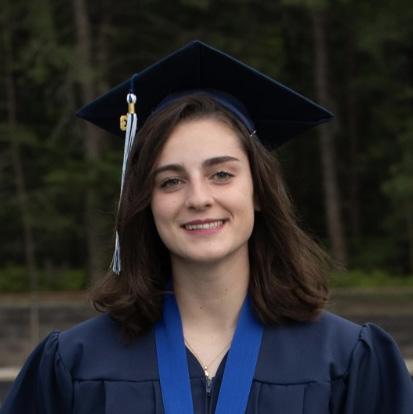
61 jacob's well
Tatiana Balasenowich, parishioner at Holy Trinity Church in Yonkers, NY, graduated Magna Cum Laude from Binghamton University with a Bachelor of Science in Business Administration with concentrations in Marketing & Management Information Systems. Since graduating, Tatiana has traveled to Europe and is currently looking for full time employment within the Entertainment Industry.
John Burk, parishioner at Holy Resurrection Church in Wayne, NJ, graduated from University of California, Los Angeles (UCLA) with a Master of Science in Electrical and Computer Engineering. He has accepted a full-time position at Northrop-Grumman in the greater Los Angeles area.
Lauren Berck, parishioner at St. Vladimir Church in Trenton, NJ, graduated Summa Cum Laude from Bellarmine University in Louisville, KY with a Bachelor of Arts in Psychology and Sociology and minor in Communication. She is currently working with an Applied Behavior Analysis (ABA) clinic in Brick, NJ.

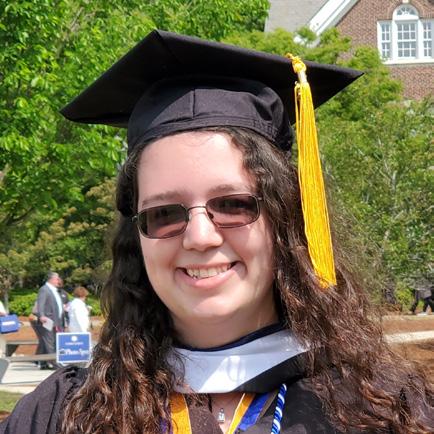

Octavia Feliciano, parishioner at Christ the Saviour Church in Paramus, NJ, graduated from The College of New Jersey (TCNJ) with a Bachelor of Arts in Journalism and Professional Writing and minor in Biology. Because she was part of TCNJ’s Honors & Scholars Program, Octavia received a second diploma for this distinction. She also served as the Director of Operations for The Signal, TCNJ's school paper, and was awarded the Robert Cole Scholarship in her senior year.
John Berezniak, parishioner at SS. Peter and Paul Church in South River, NJ, graduated Rutgers University’s School of Public Health with a Master of Science in Epidemiology.

Michael Gedevani, parishioner at SS. Peter and Paul Church in Manville, NJ, graduated with High Honors from Rutgers University with a Bachelor of Science in Business
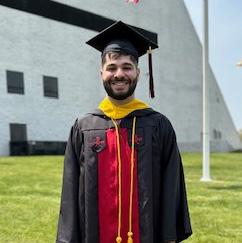
jacob's well 62
College
Analytics and Information Technology and minor in Supply Chain Management. He is already working in his profession.
Anna Kaliashvili, parishioner at SS. Peter and Paul Church in Manville, NJ, graduated with High Honors from Rutgers University with a Bachelor of Science in Civil Engineering. She is working in her profession at a construction company.
Andrew Popadics, parishioner at Holy Resurrection Church in Wayne, NJ, graduated from NYU Silver School of Social Work with a Master of Social Work and Counseling. In addition to his academic courses, Andrew completed internships at The Institute of Community Living and MTZ Counseling, where he will begin his career as a psychotherapist.
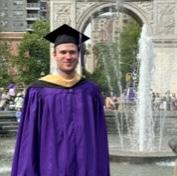
Sarah Levitsky, parishioner at Holy Resurrection Church in Wayne, NJ, graduated Magna Cum Laude from Wake Forest University with a Bachelor of Arts in Psychology and minor in Entrepreneurship. She plans to reside in New York City where she will begin her professional career with Mastercard.

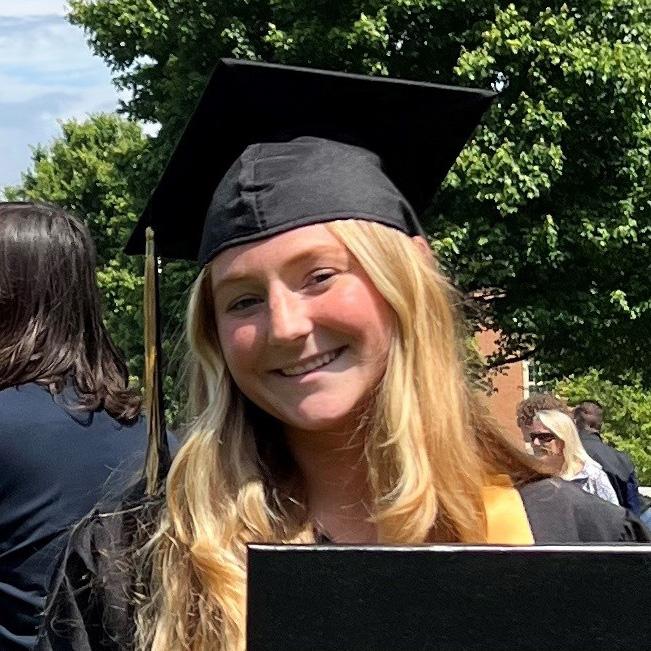
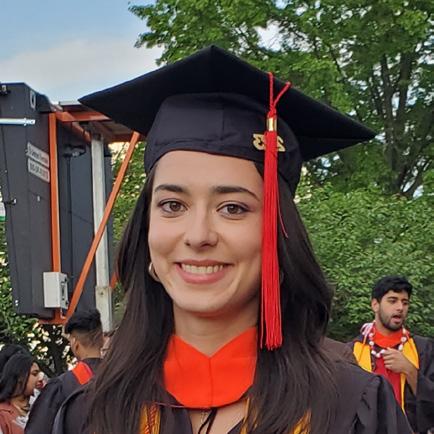
Jeremy Posluszny, parishioner at SS. Peter and Paul Church in South River, NJ, graduated Cum Laude from Rutgers University Law School with a Juris Doctor. He was honored for his service on the Rutgers University Law Review and awarded the Rutgers Law School Award for Excellence in Labor & Employment Law. Jeremy will clerk for Judge Greta Goodwin Brown of the NJ Superior Court.
G. Daniel Macko, parishioner at Christ the Savior Church in Ballston Lake, NY, graduated Magna Cum Laude from SUNY Geneseo with a Bachelor of Arts in History and Anthropology. He was awarded a fellowship to attend SUNY Oneonta's Cooperstown Graduate Program (CGP) to pursue a Master’s in Museum Studies.
Alexis Steffaro, parishioner at SS. Peter and Paul Church in South River, NJ, graduated with honors from The University of Nottingham UK with a Master of Arts in International Security and Terrorism. She joined the University’s A Cappella group, RadioOctave, and won many international competitions. She now works in Washington DC.

63 jacob's well






 and Talia Sheehan
and Talia Sheehan









 BEATRICE OLDEROG is a sophomore at Acton Academy Verona High School and a parishioner at Saint Mary Magdalene Orthodox Church in New York City.
BEATRICE OLDEROG is a sophomore at Acton Academy Verona High School and a parishioner at Saint Mary Magdalene Orthodox Church in New York City.






 by JOHN LIVICK-MOSES, LICSW
by JOHN LIVICK-MOSES, LICSW














 by Sherry Shenoda
by Sherry Shenoda

































